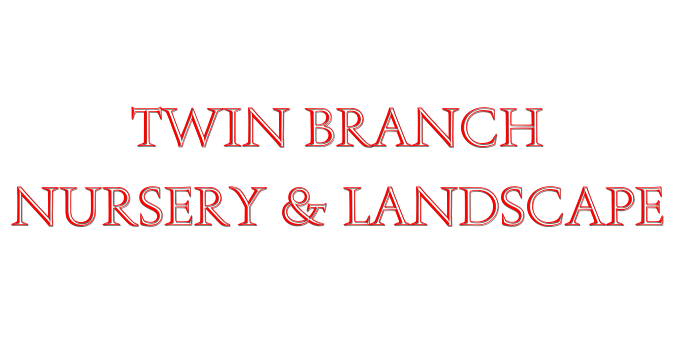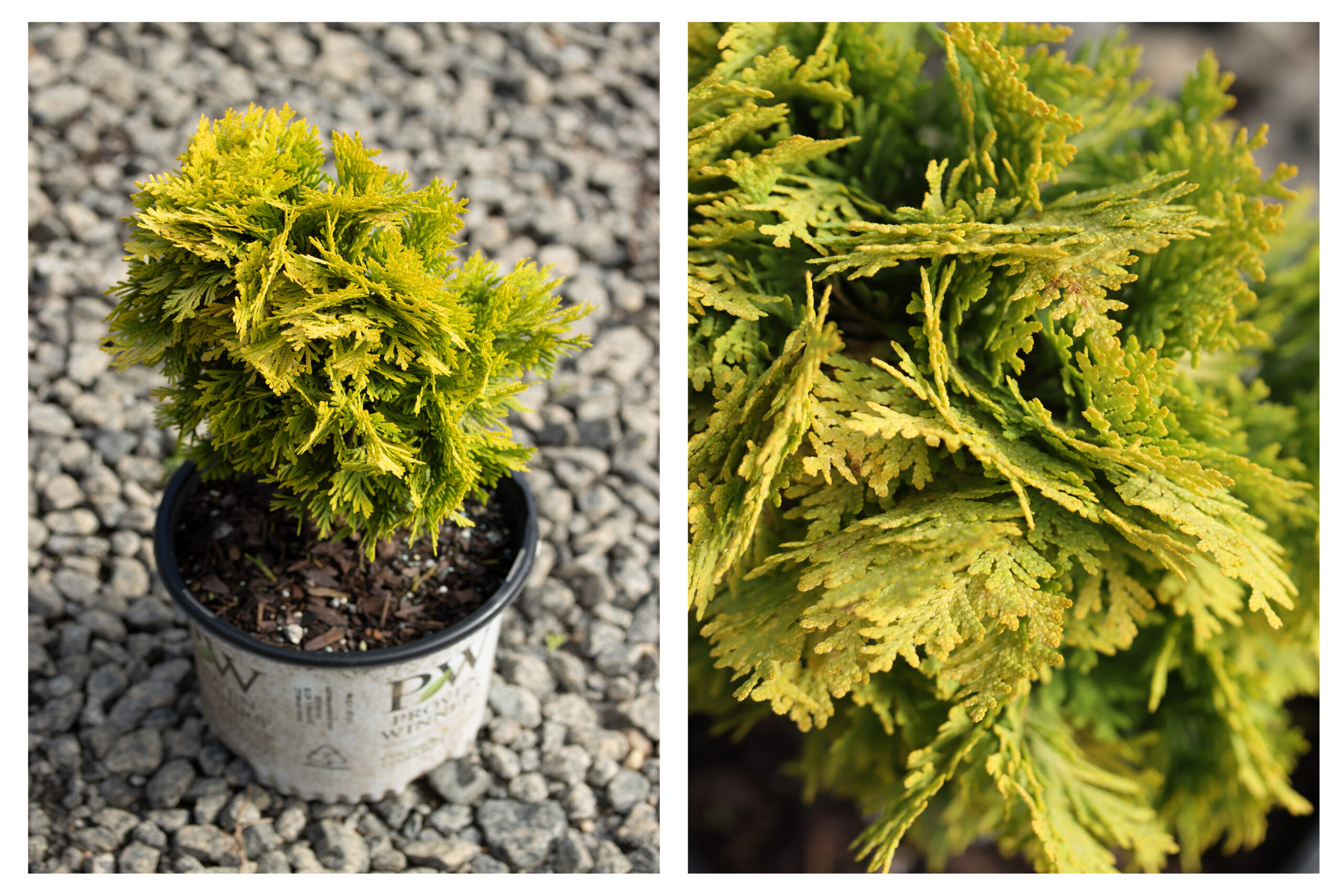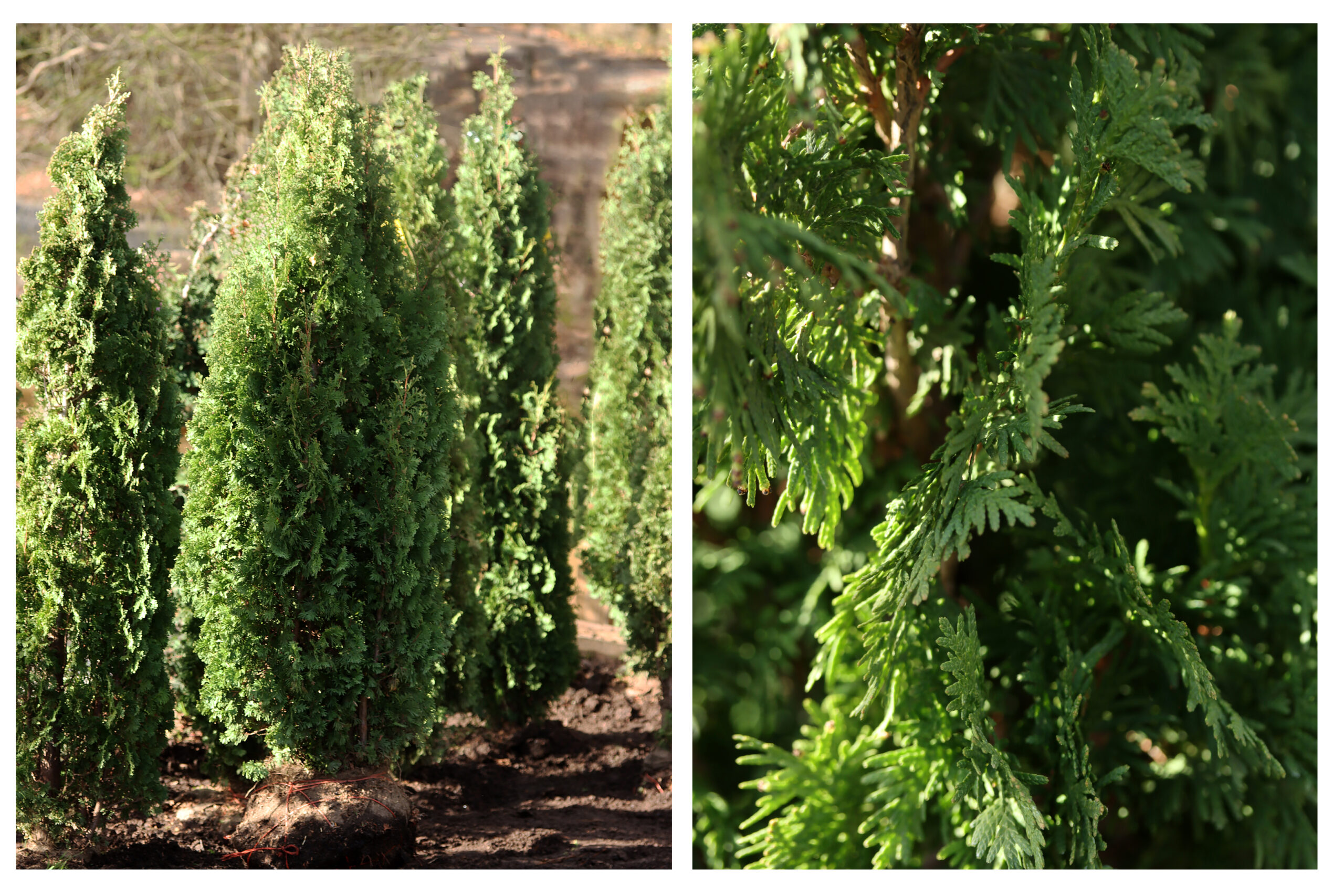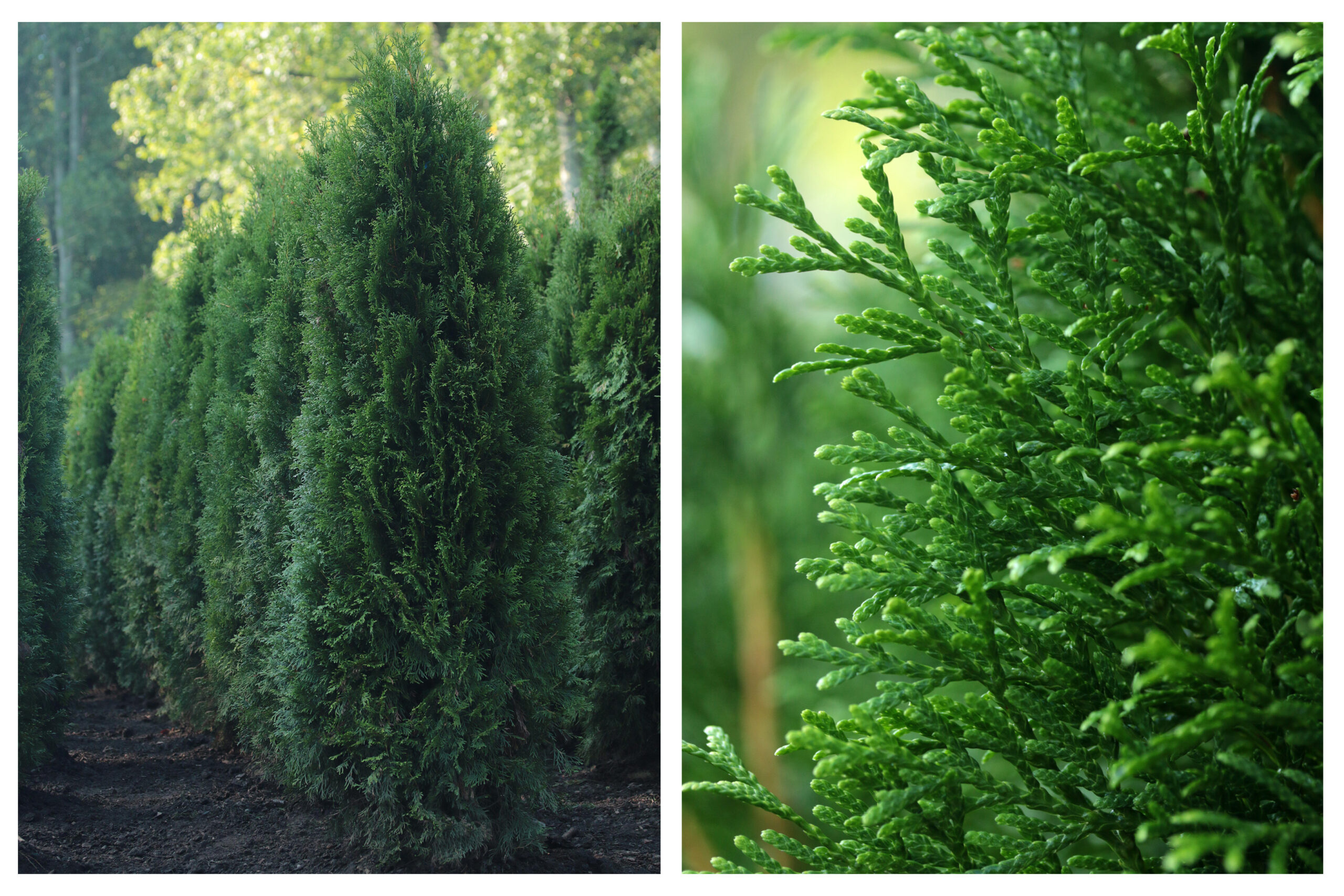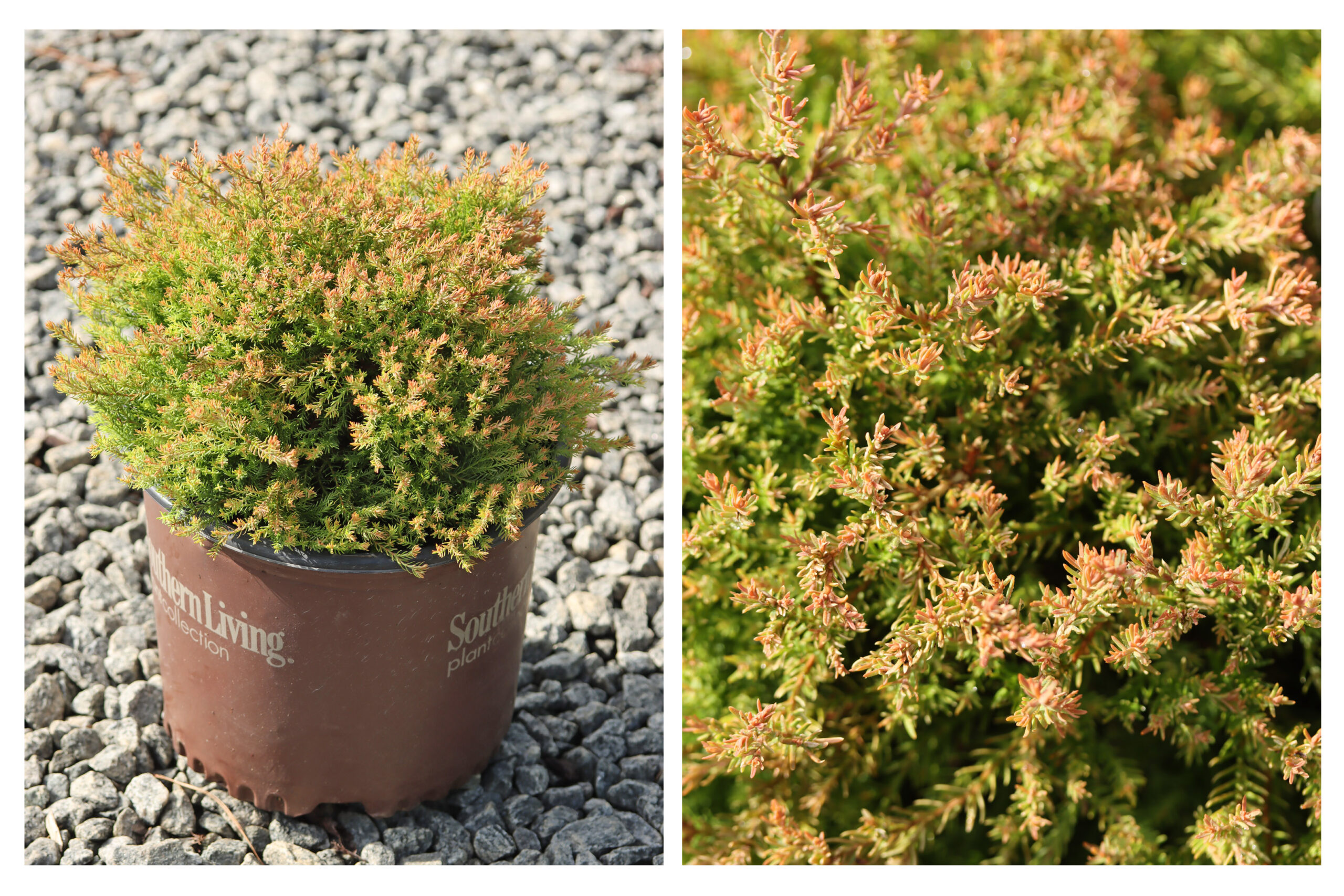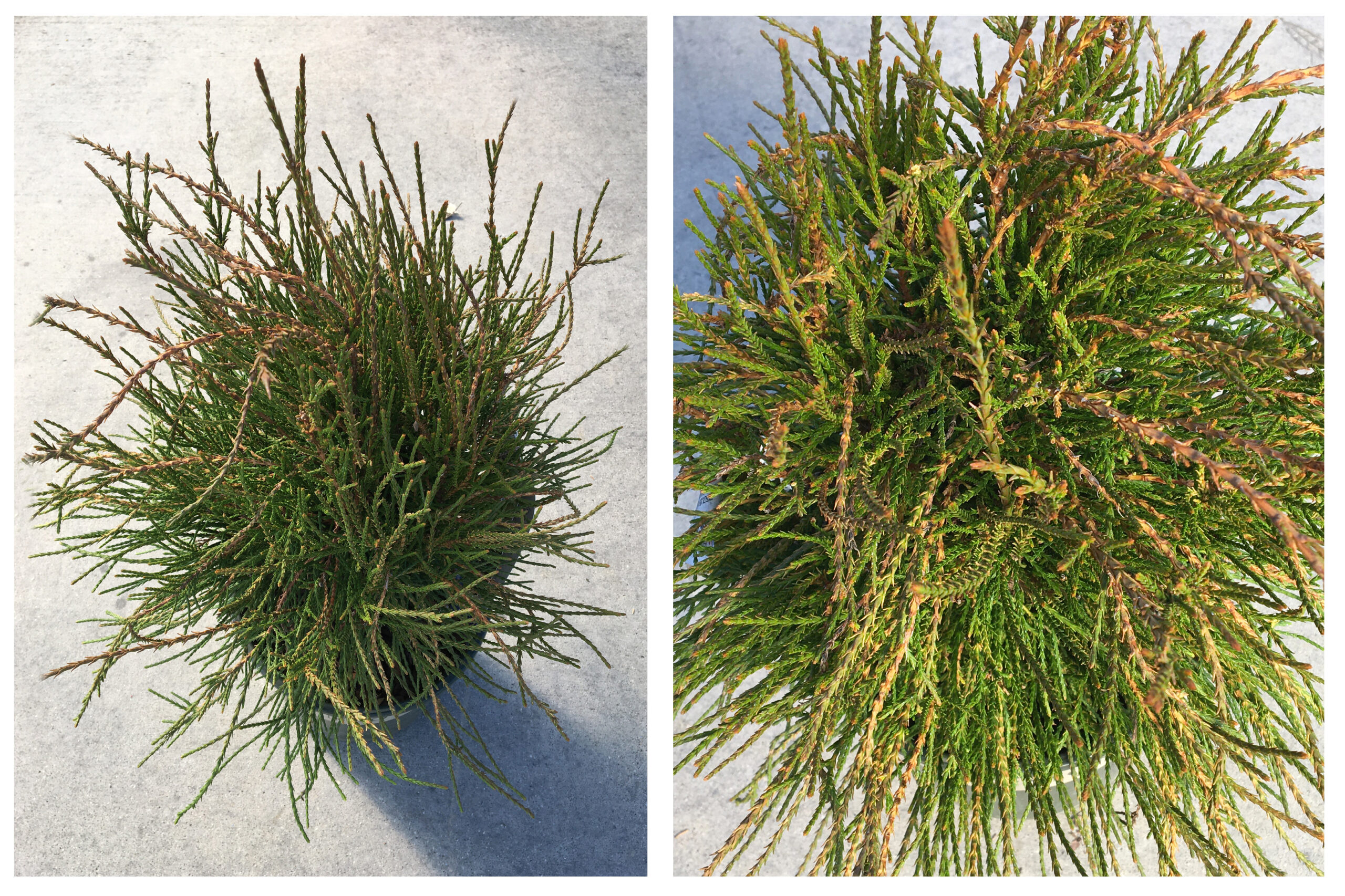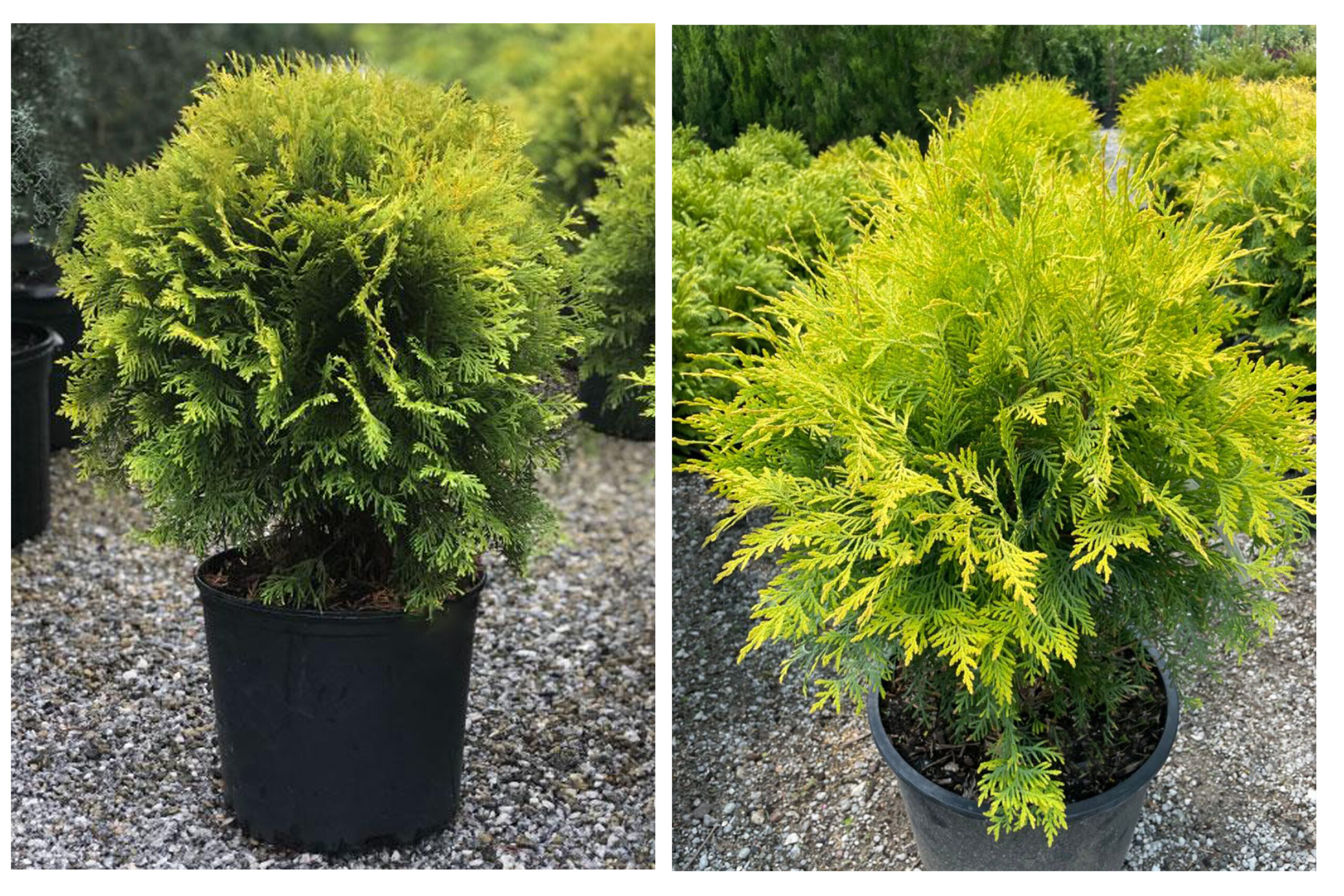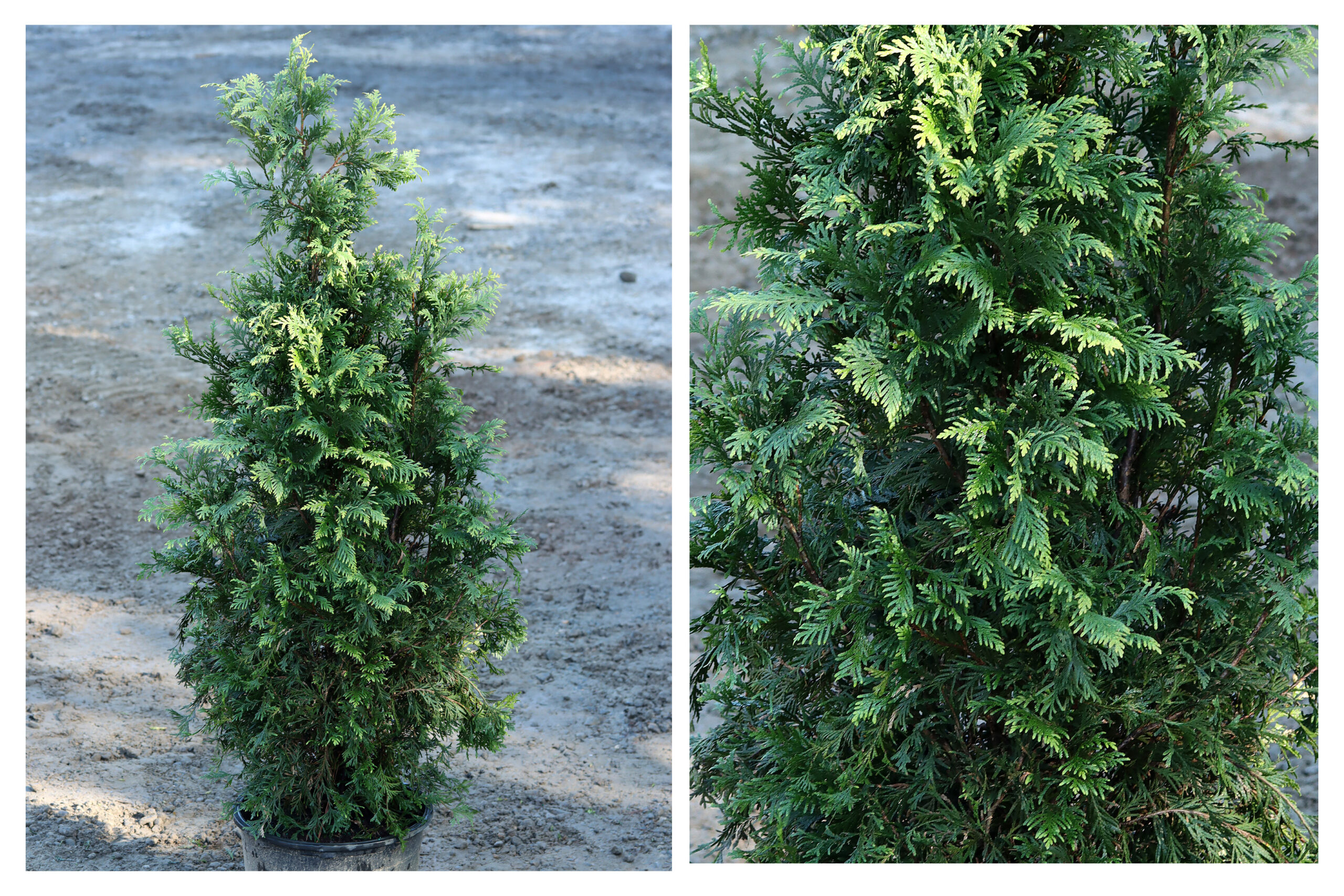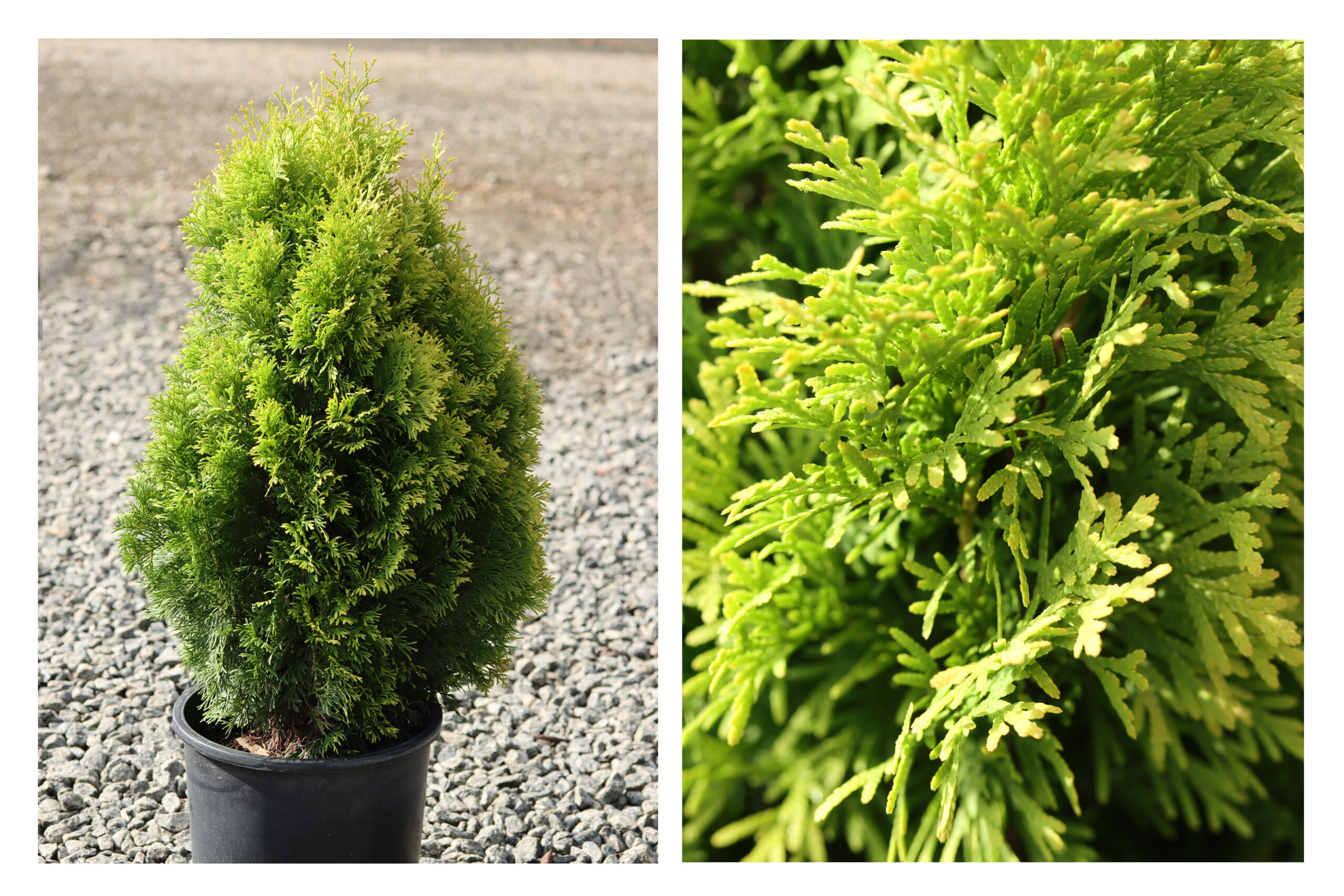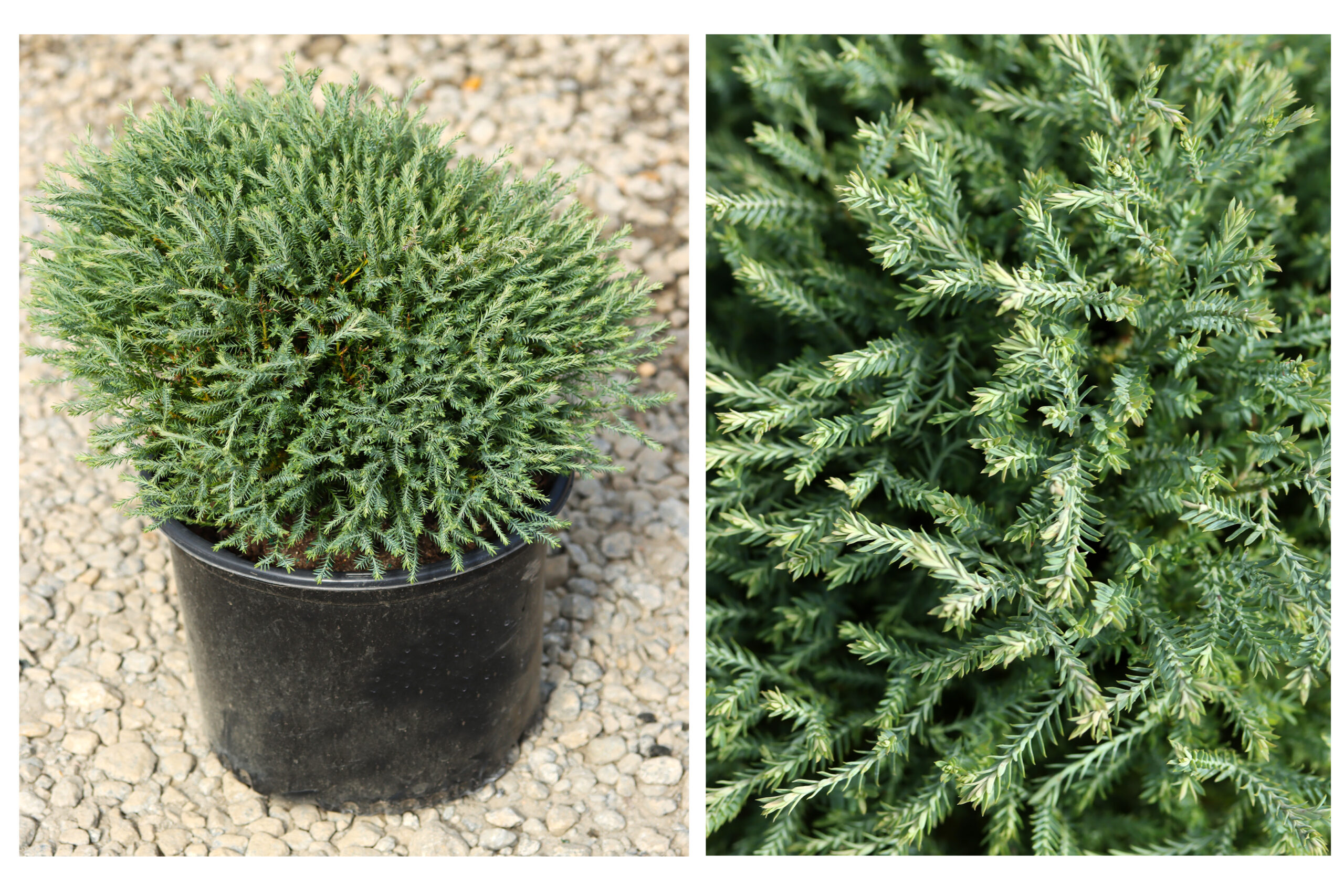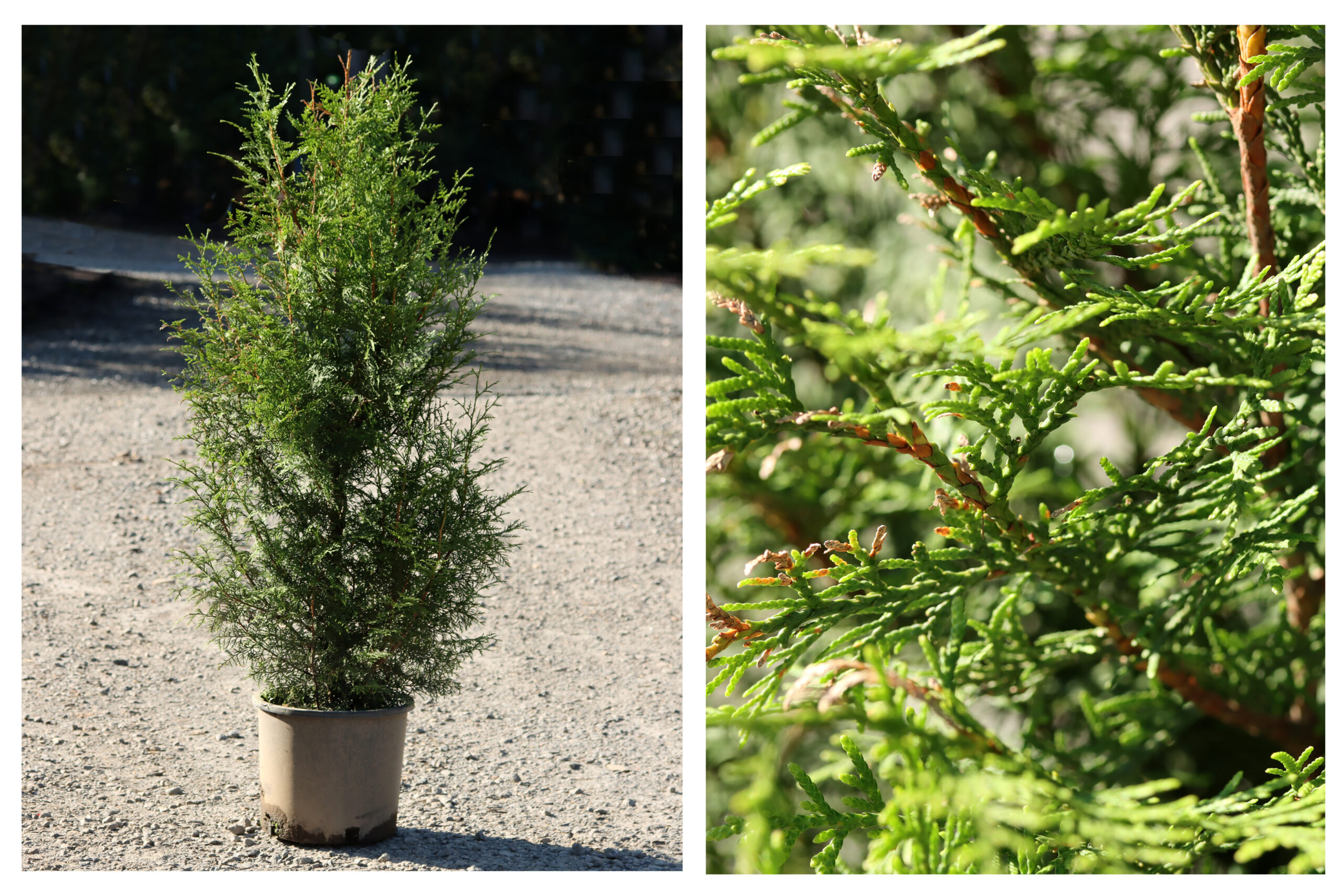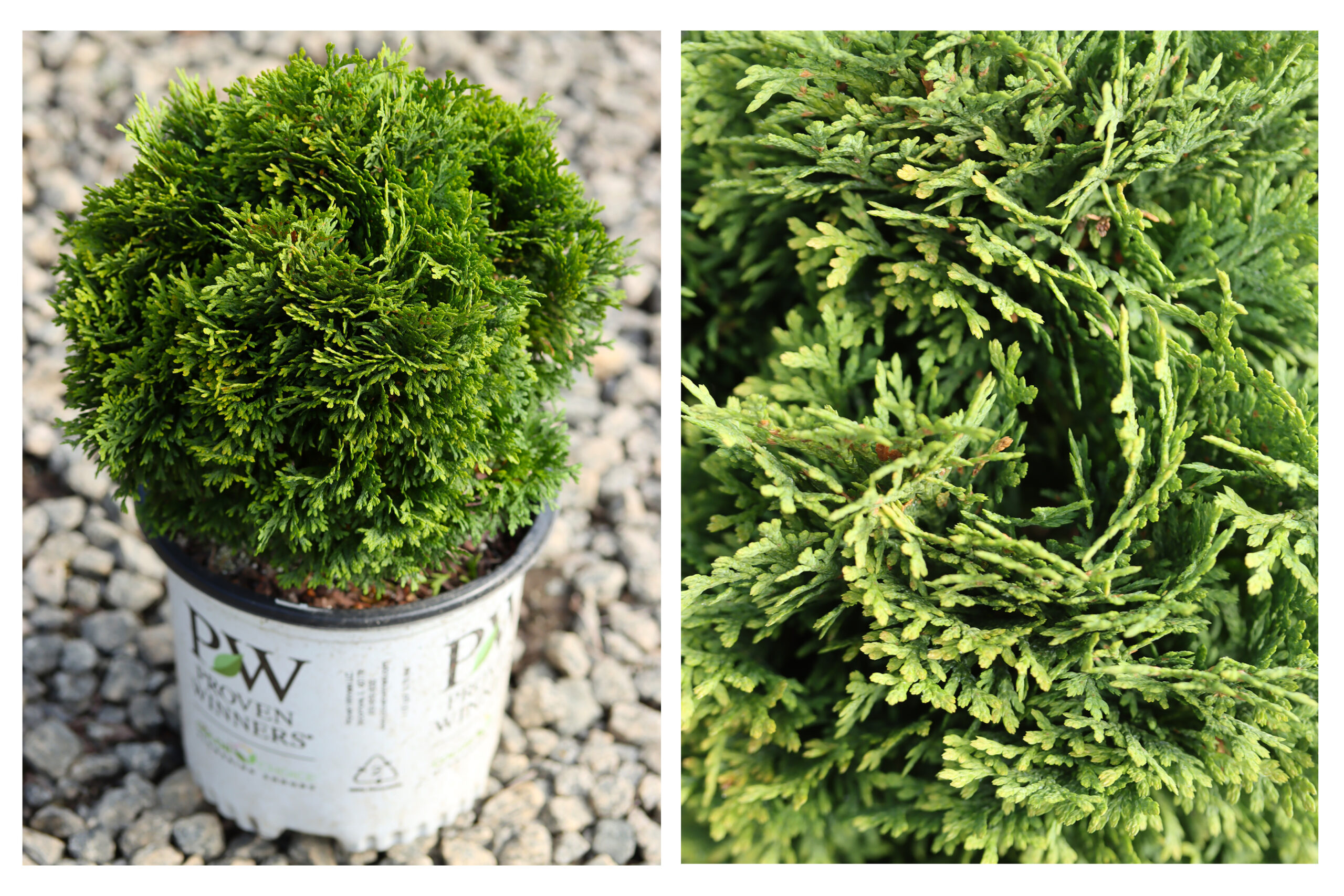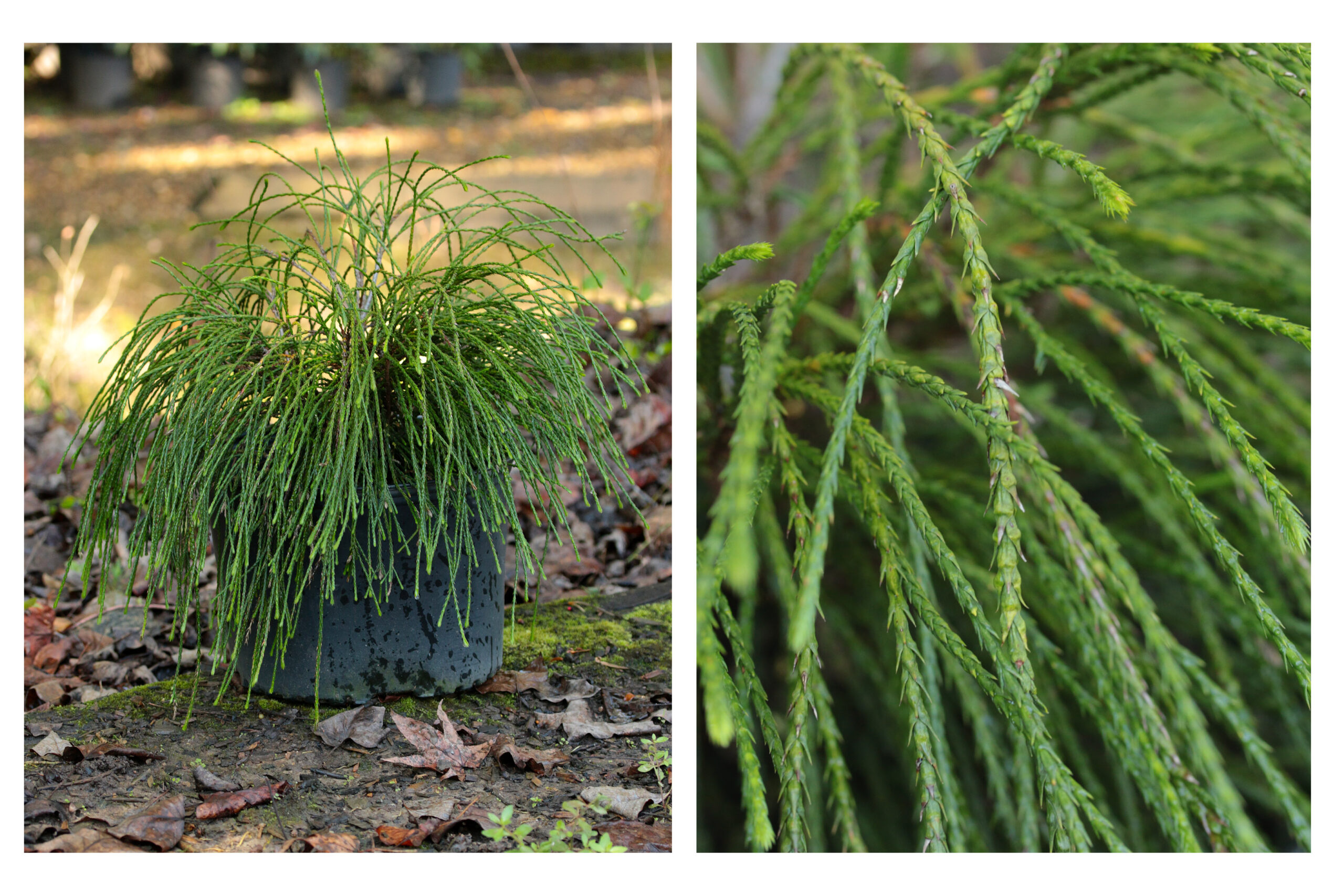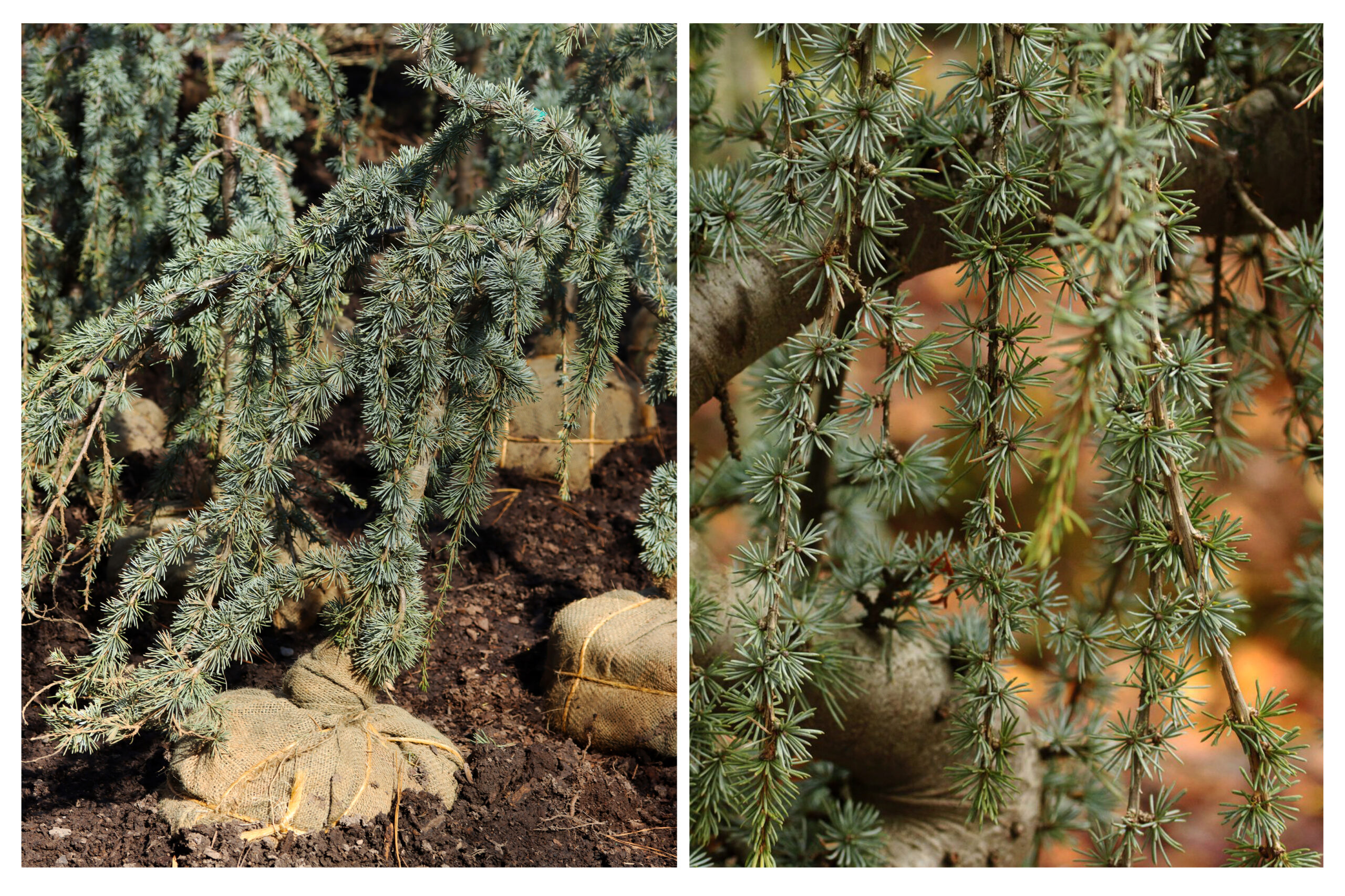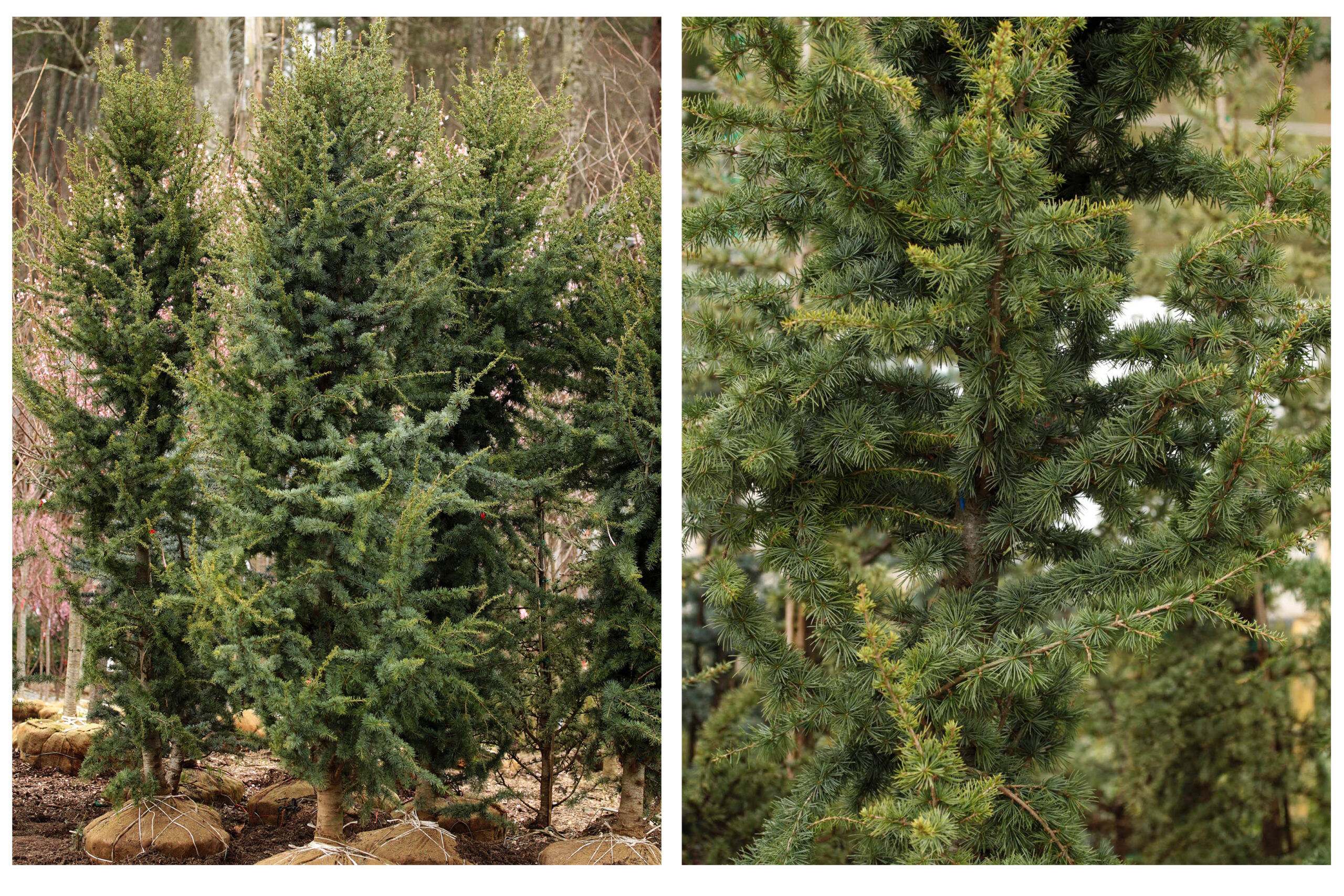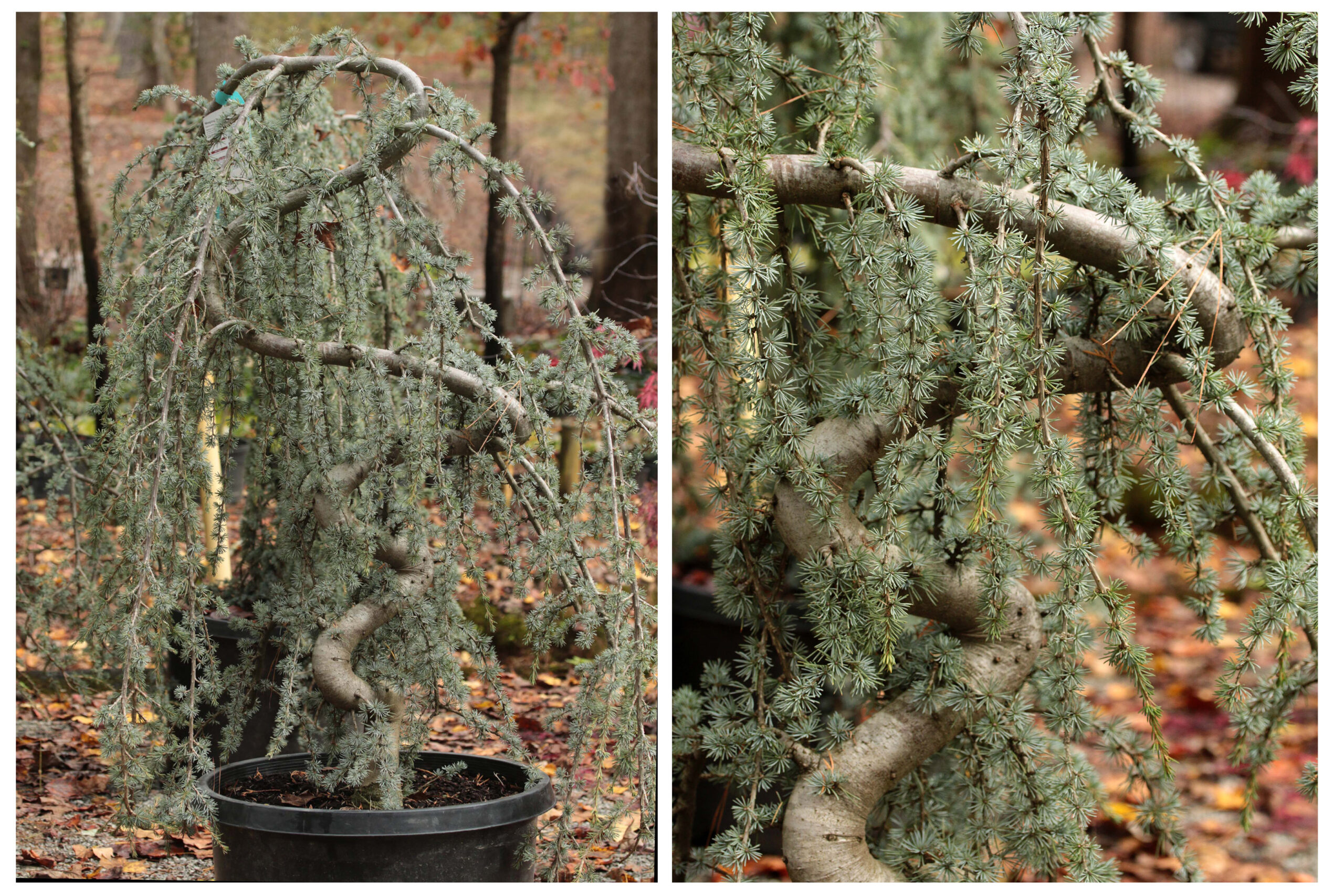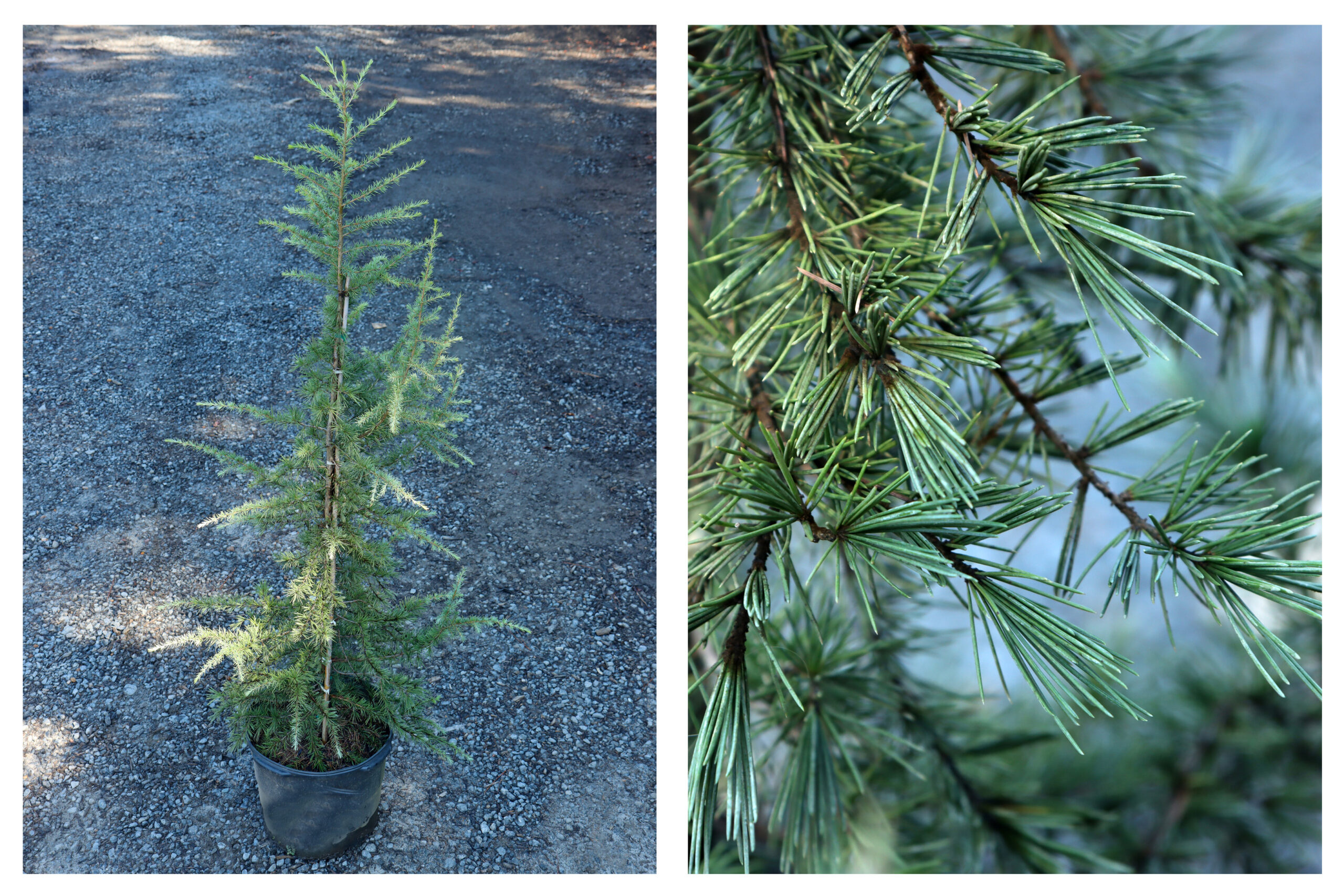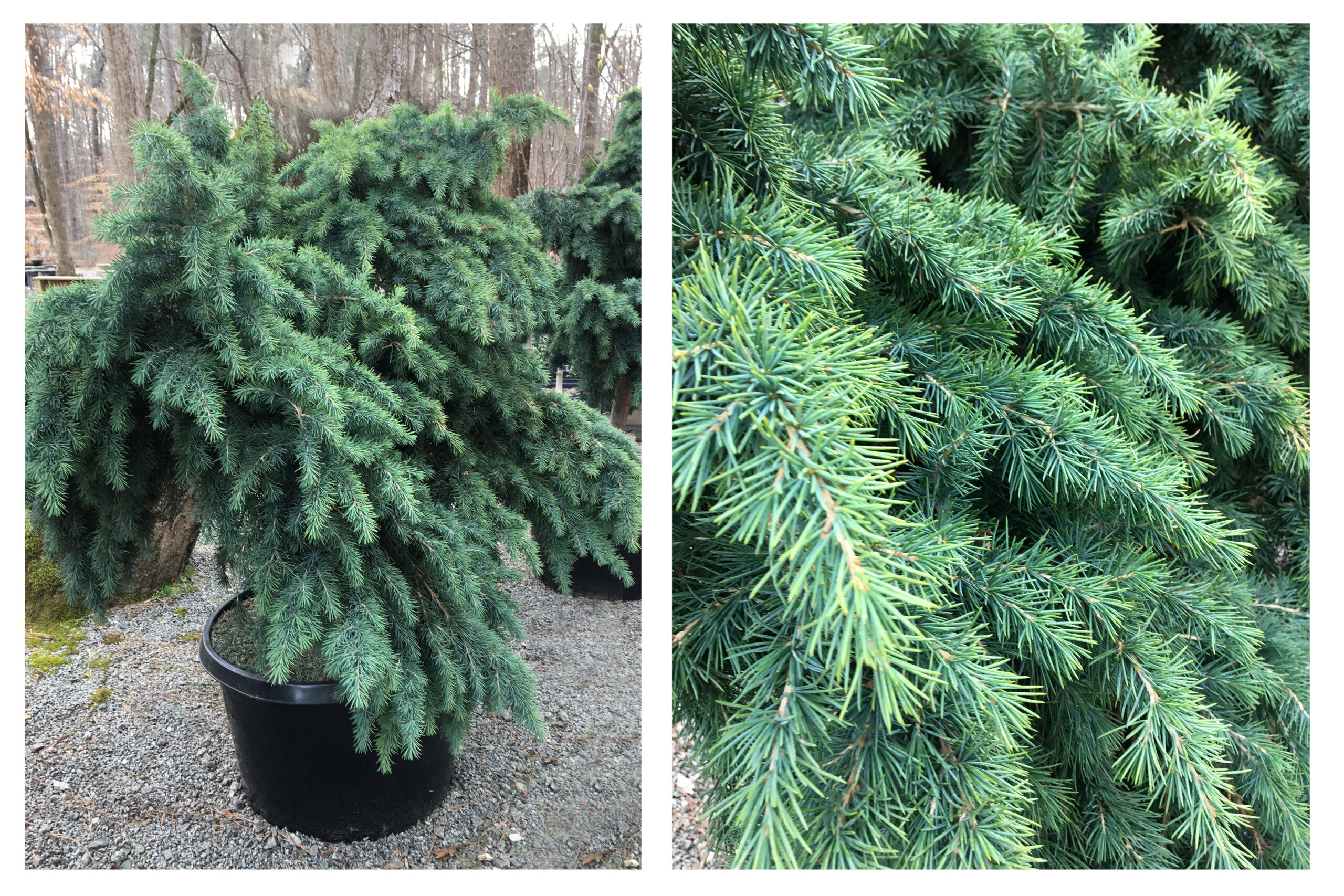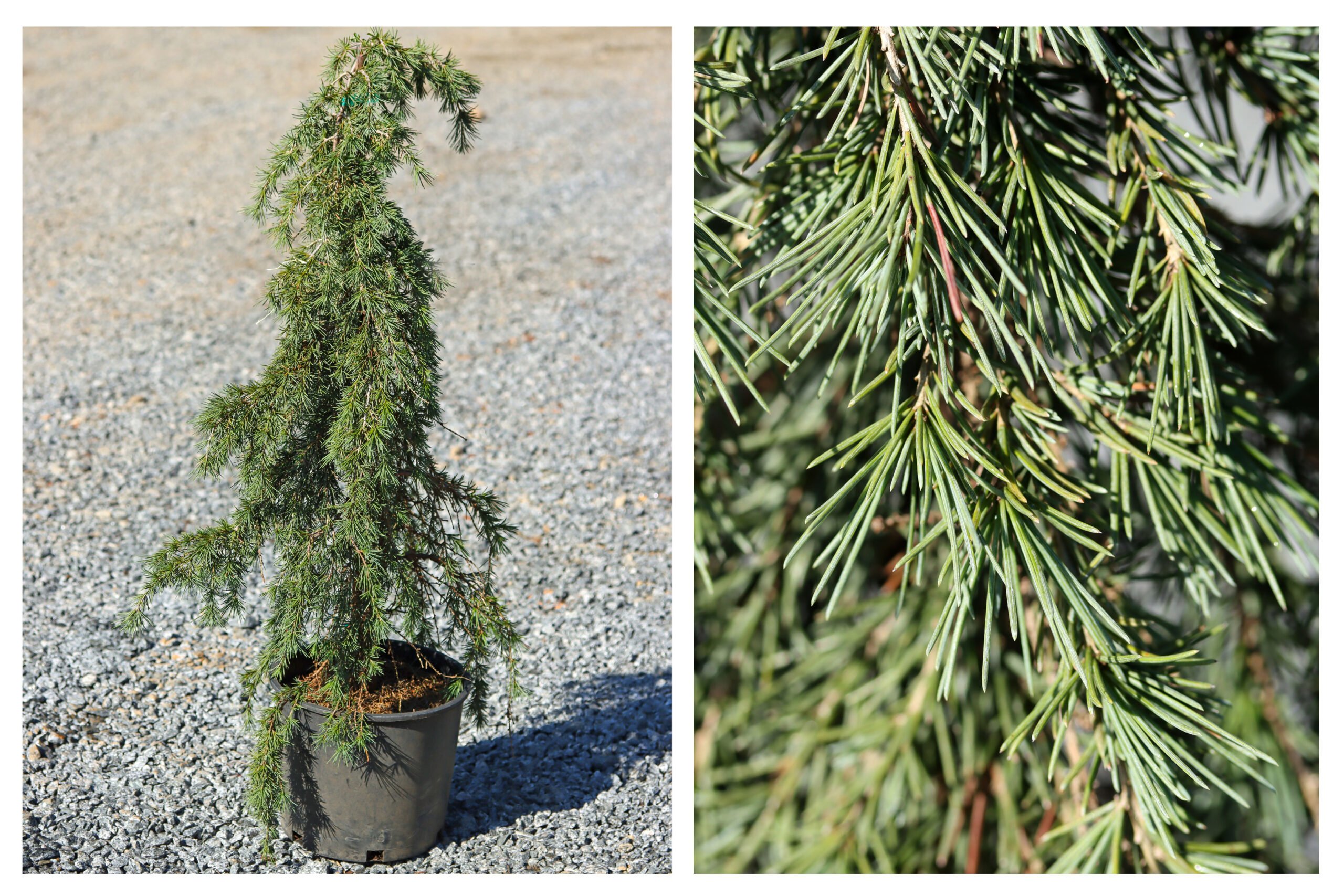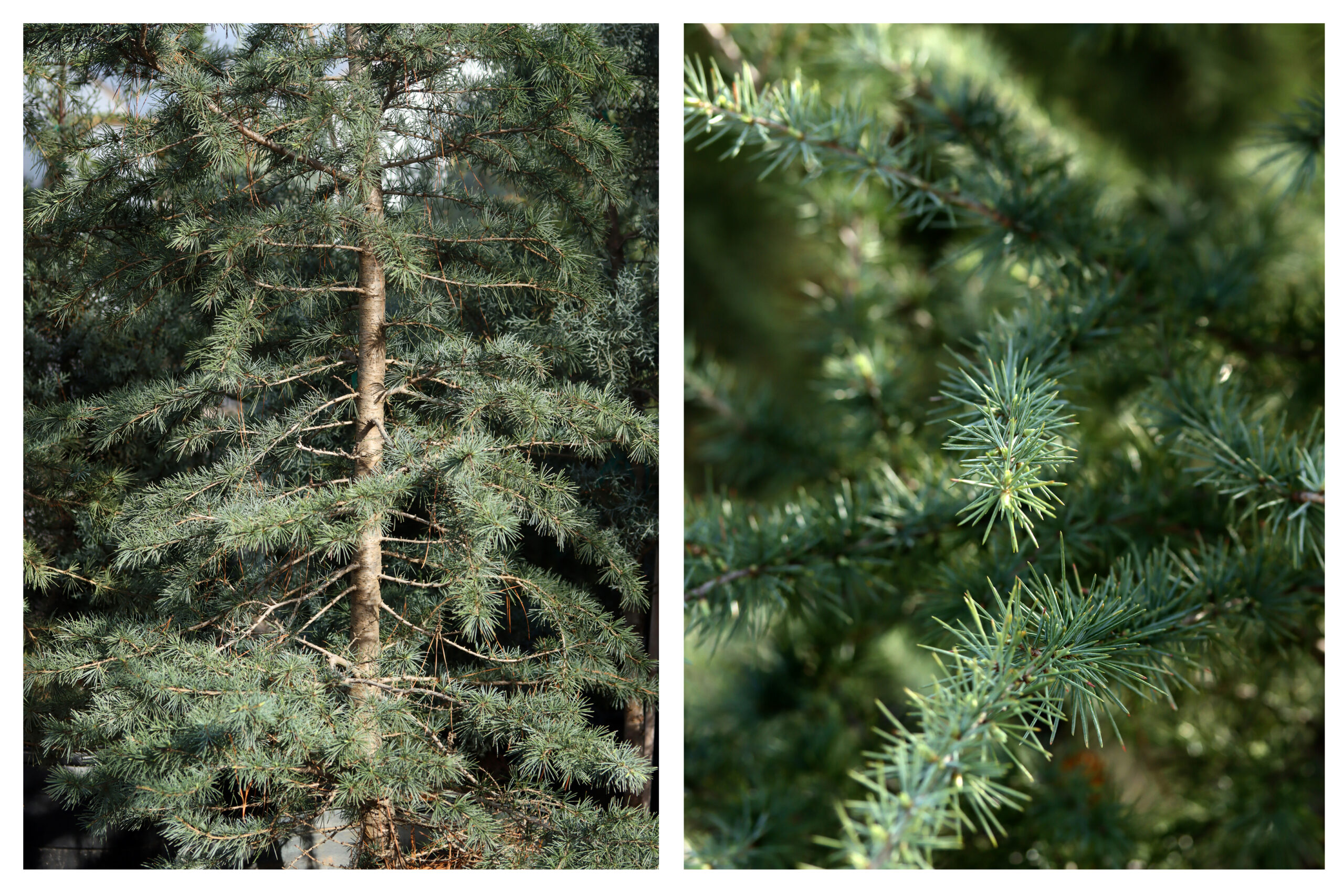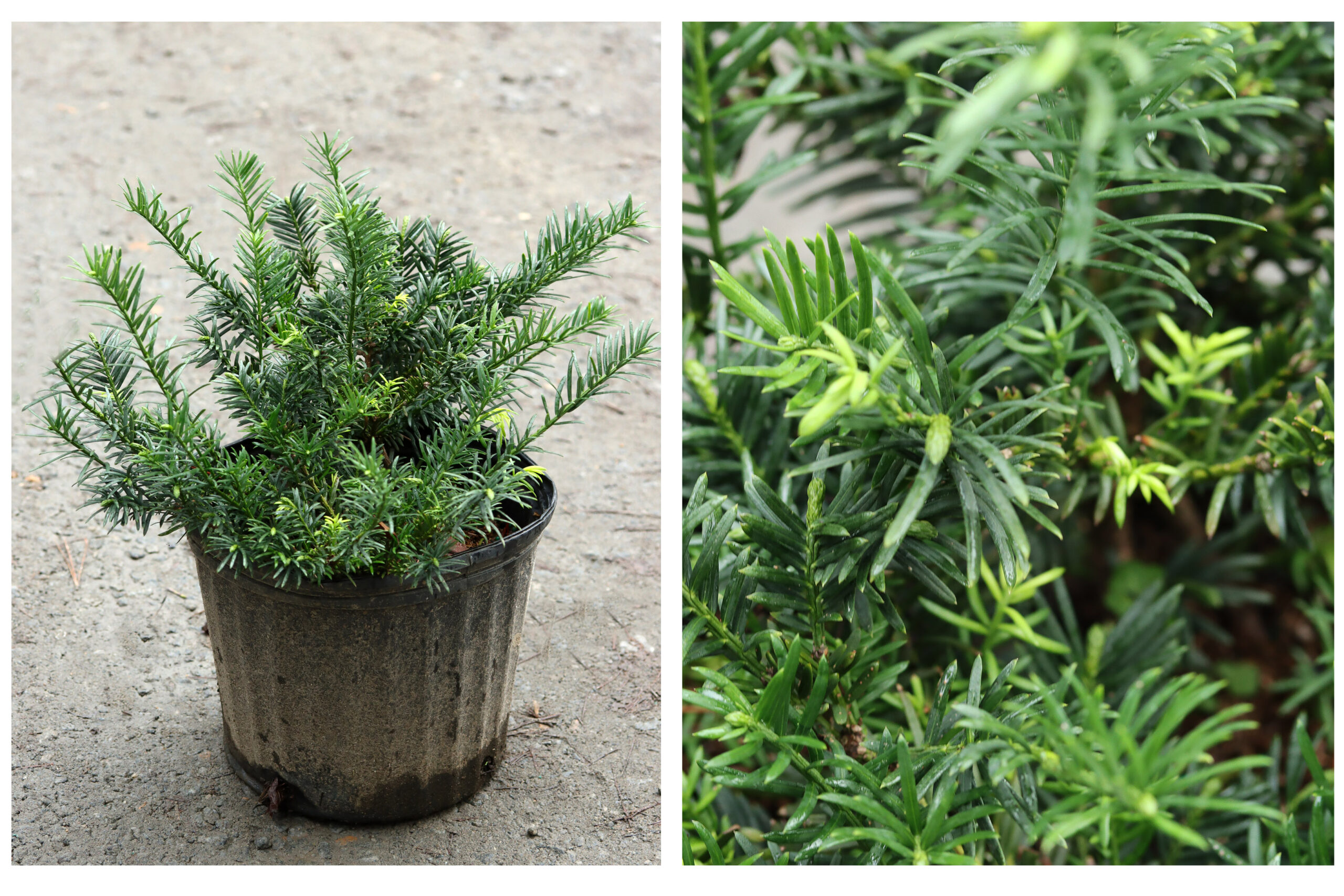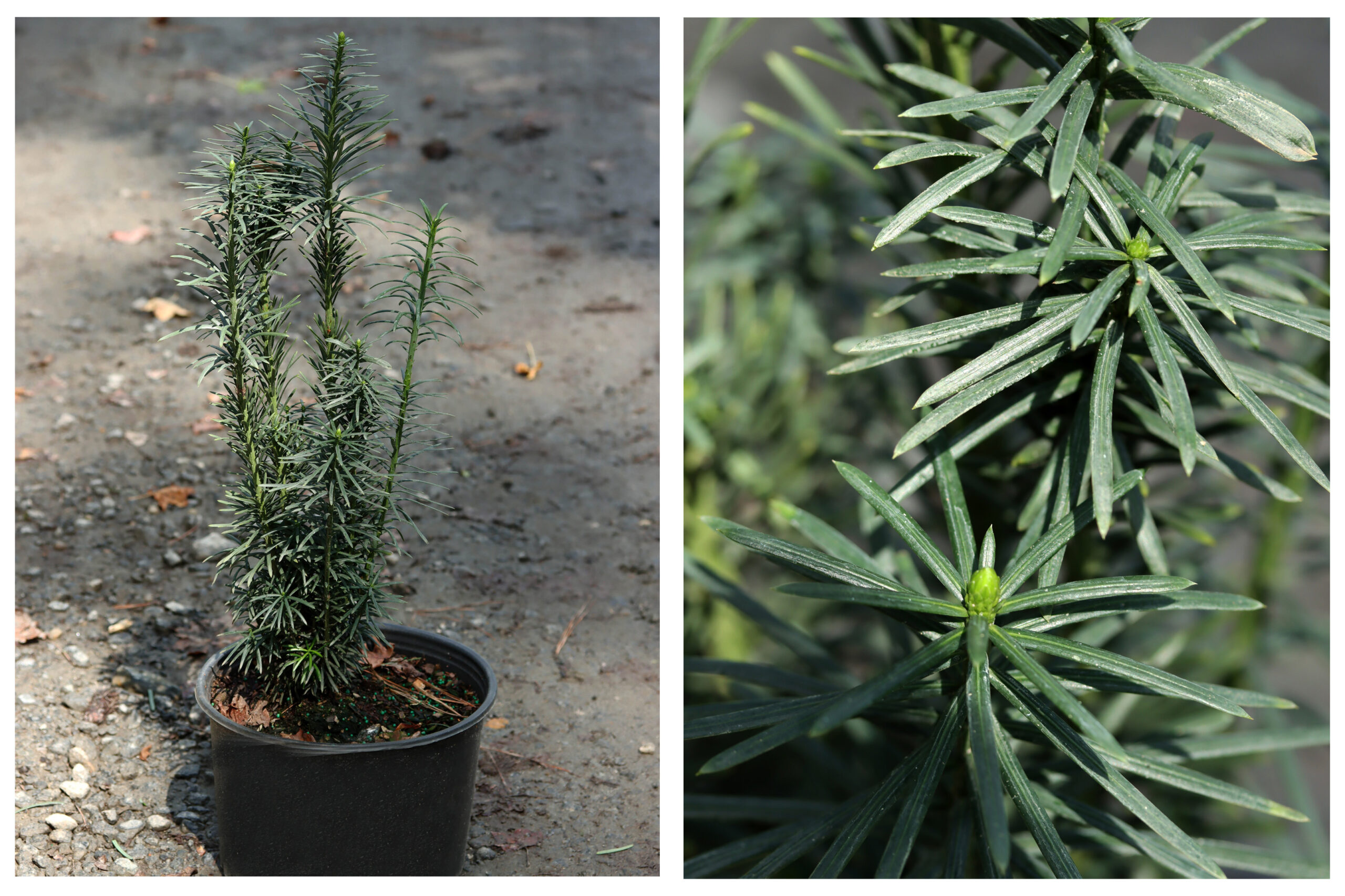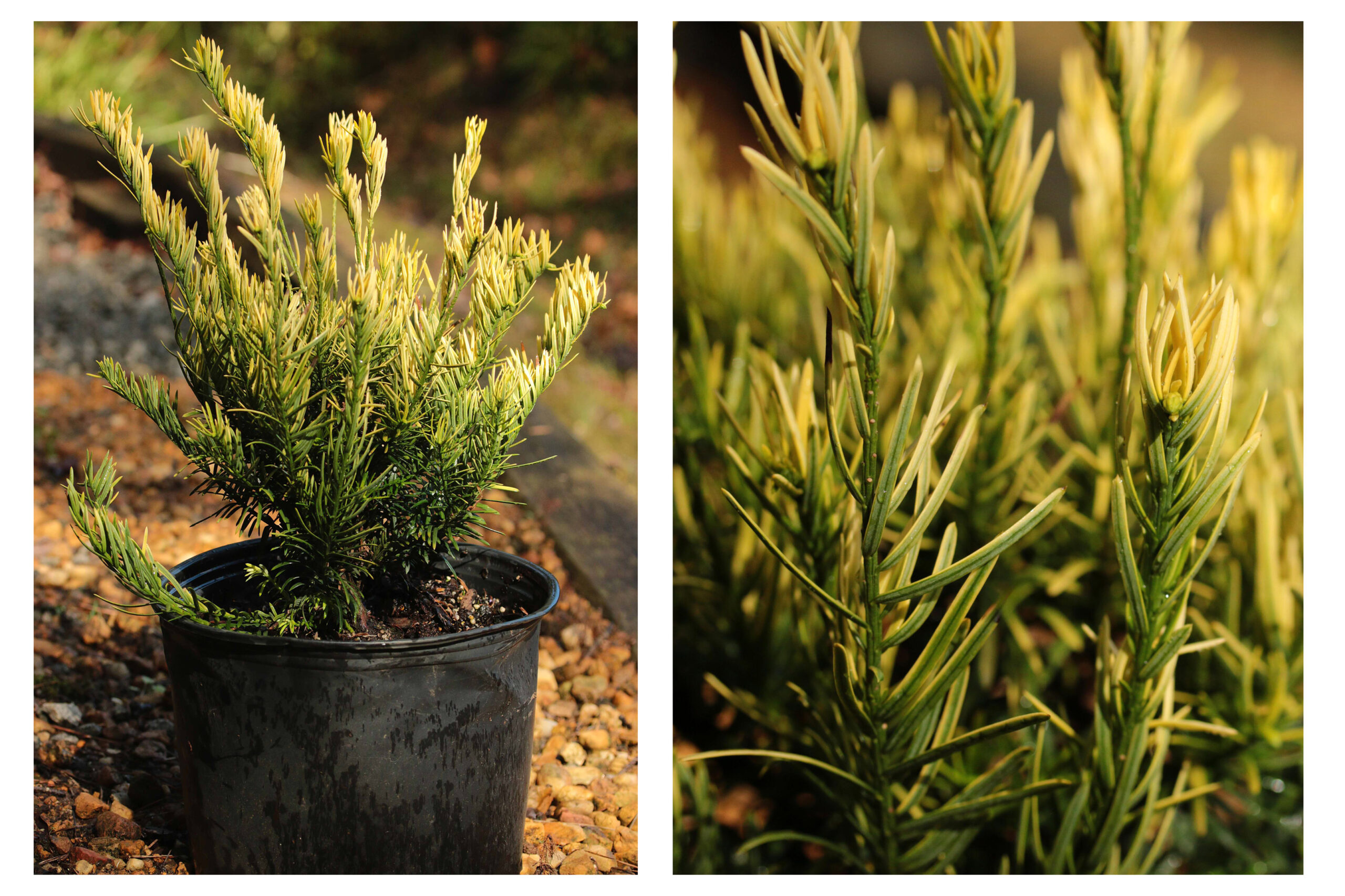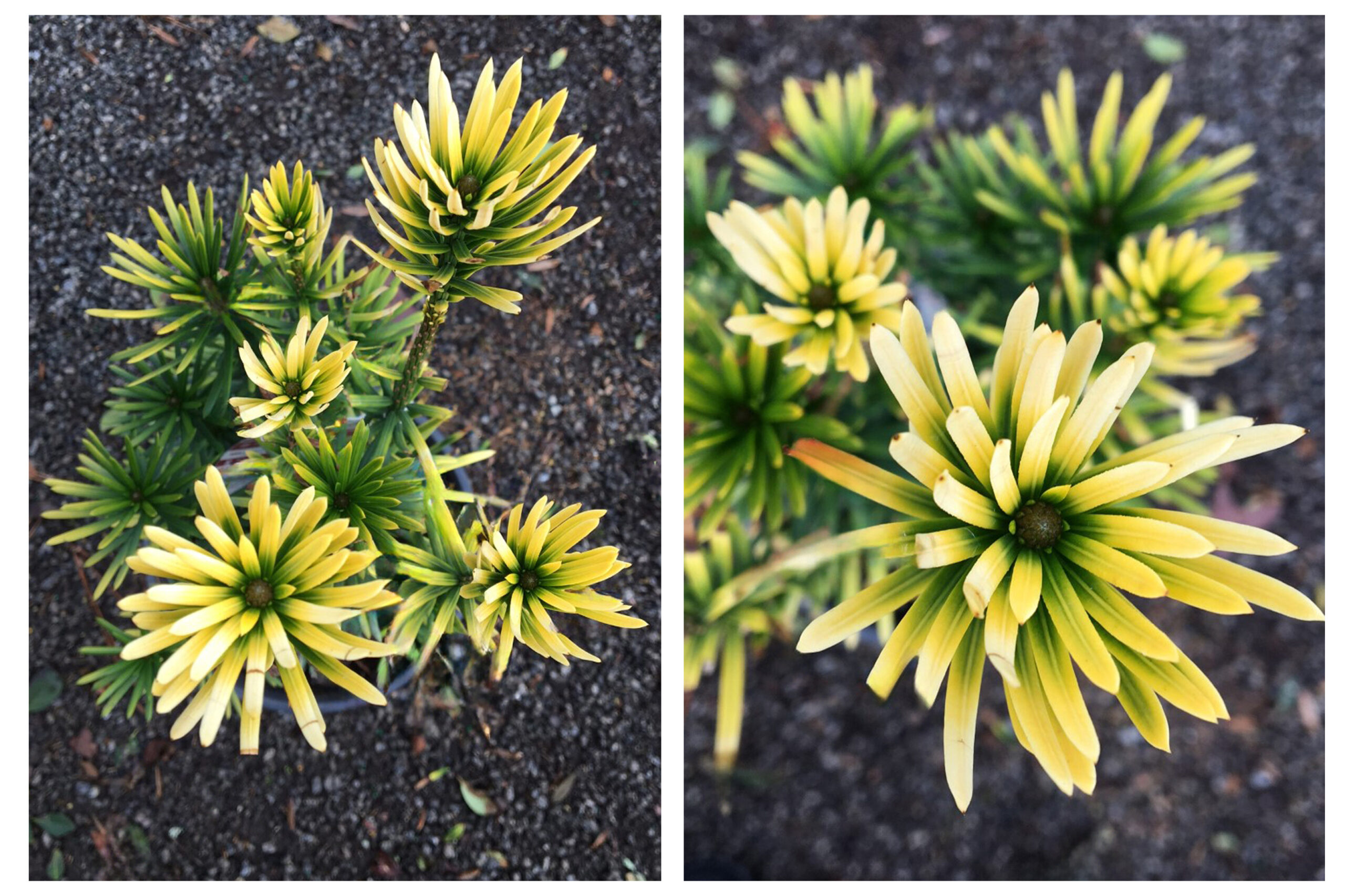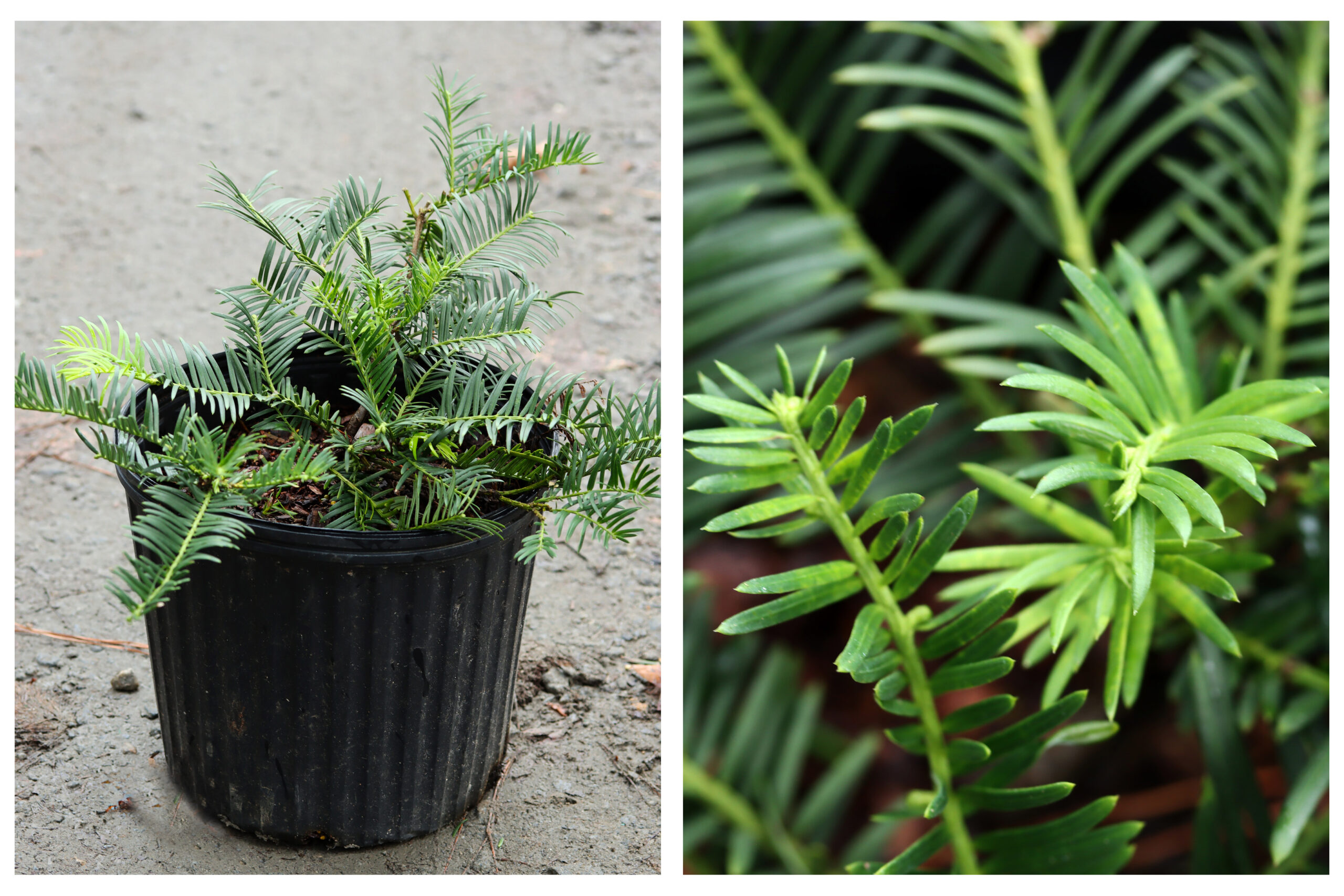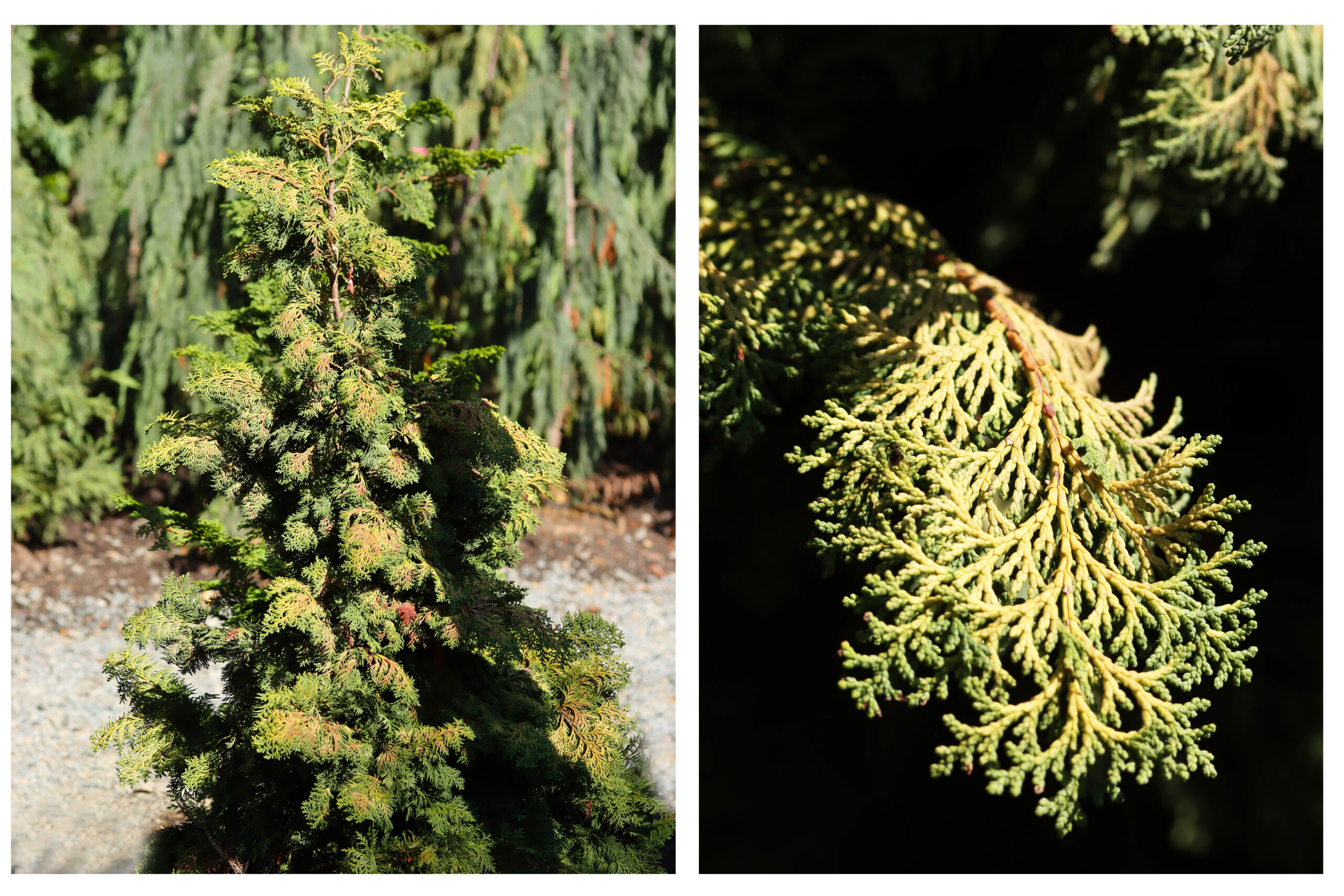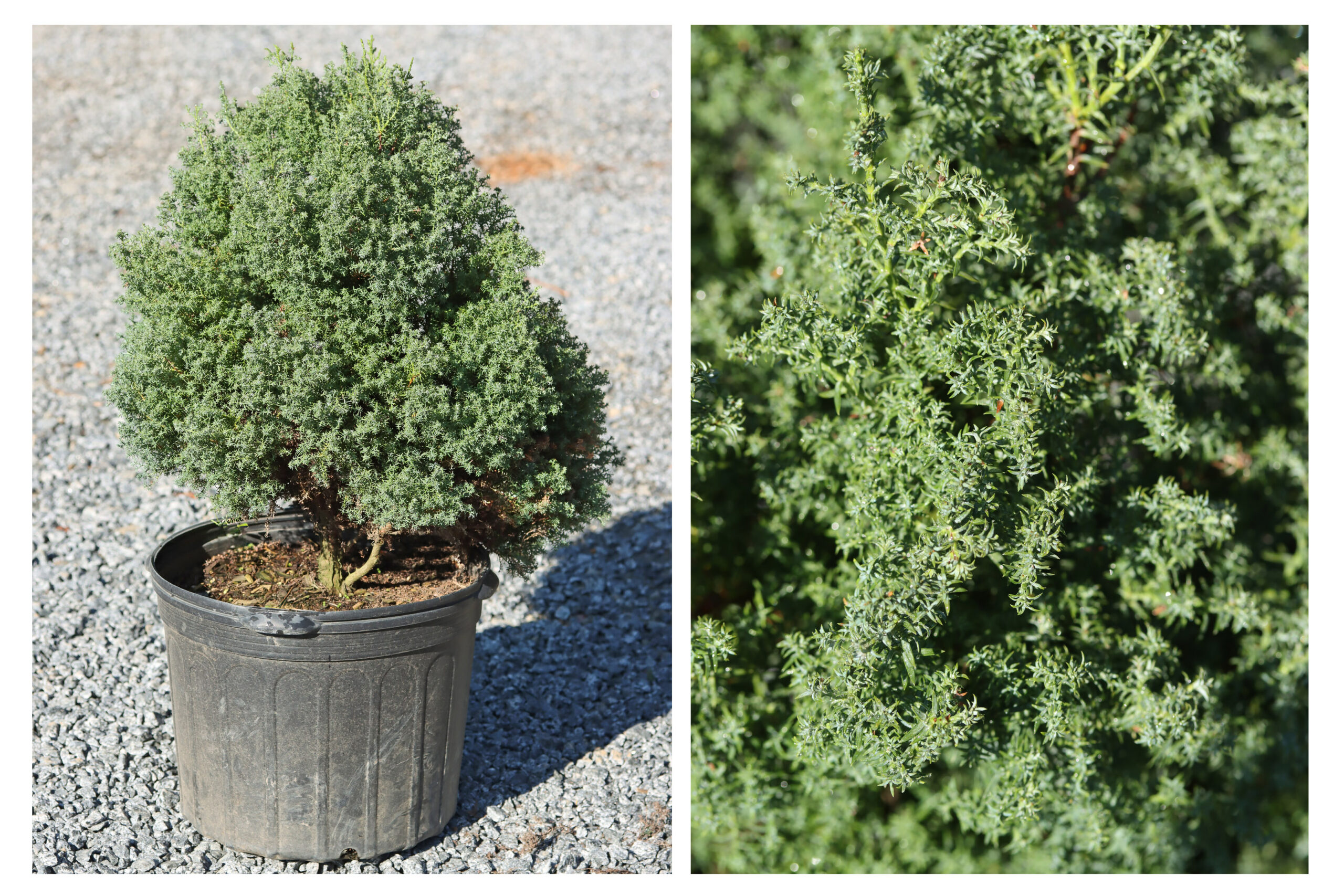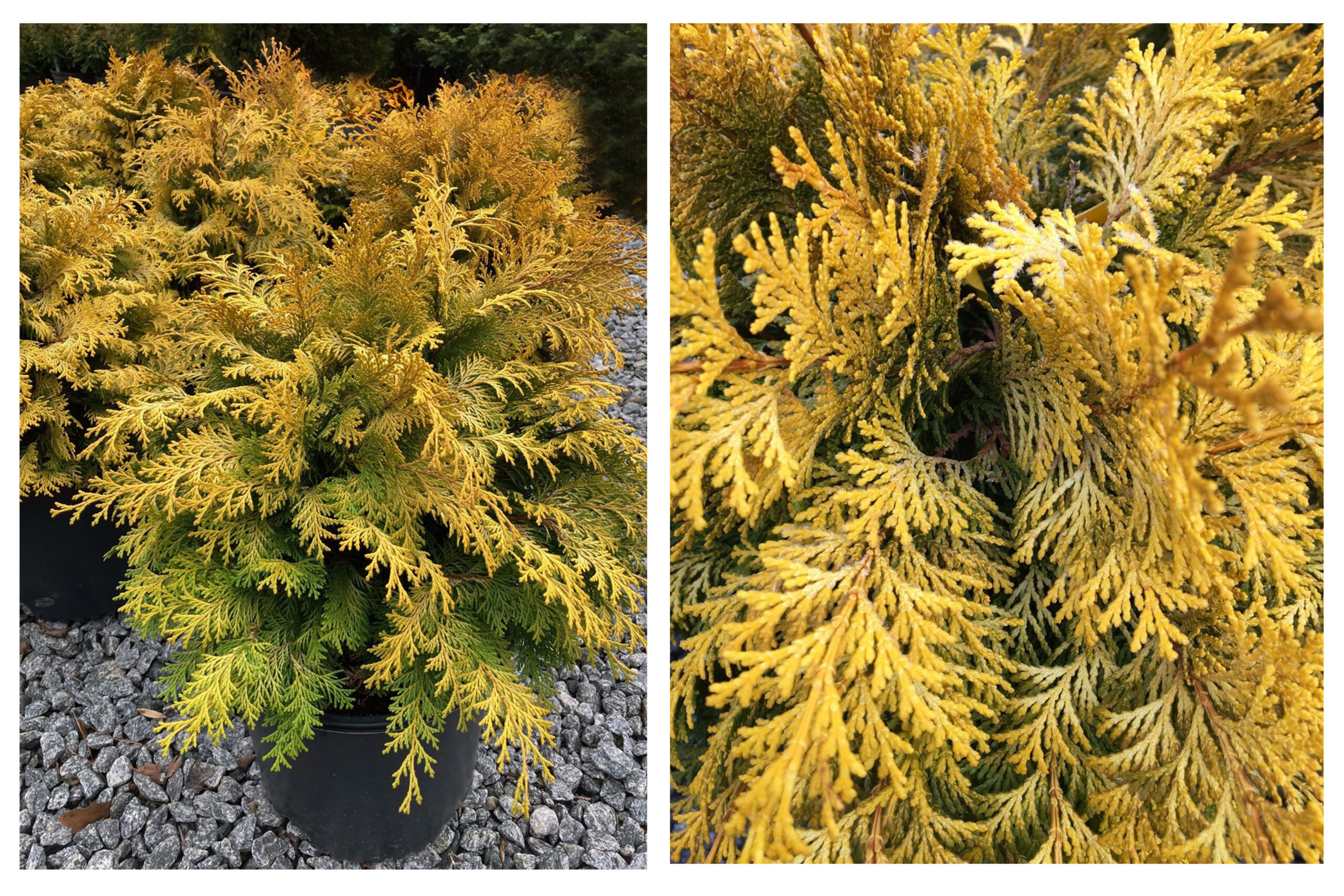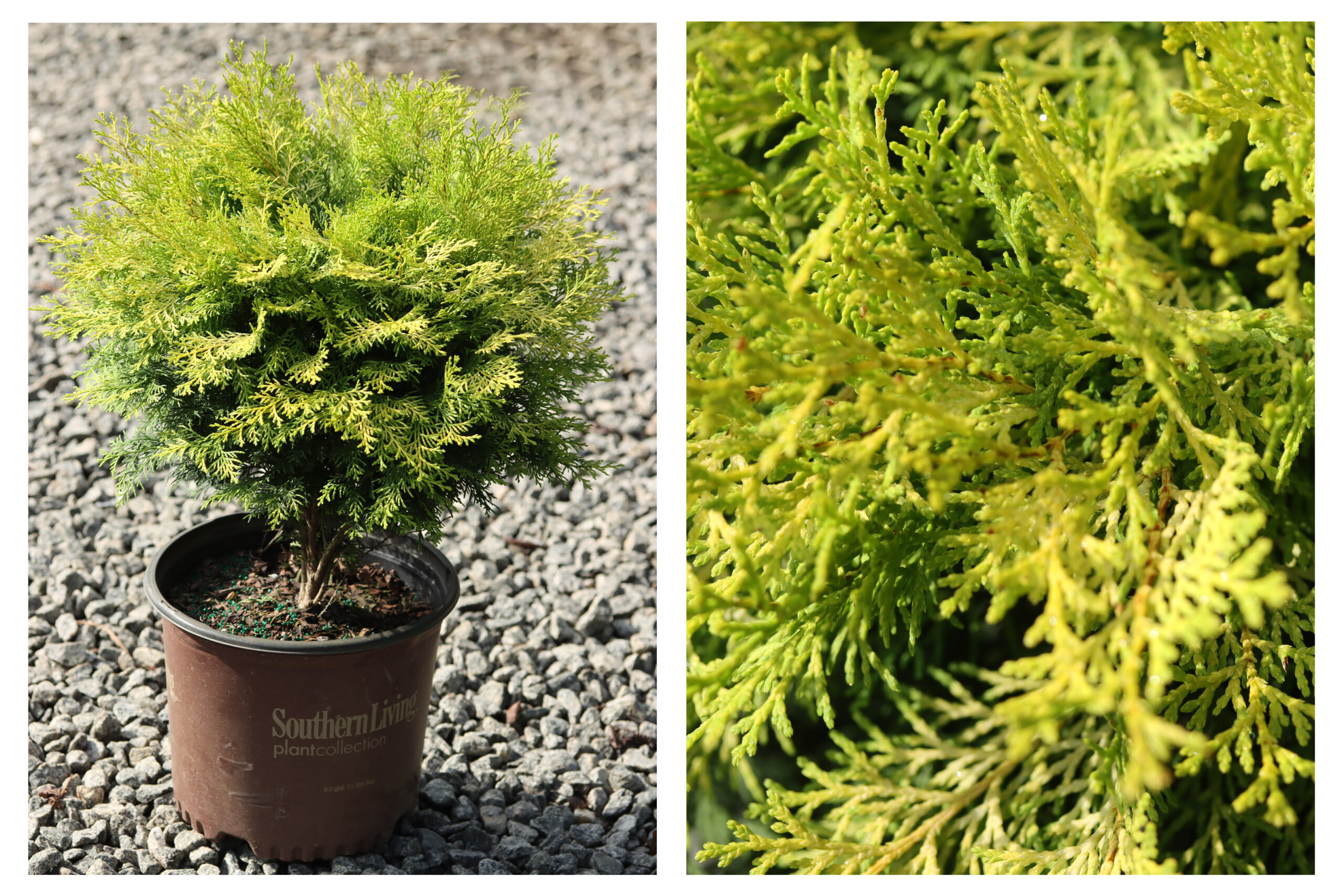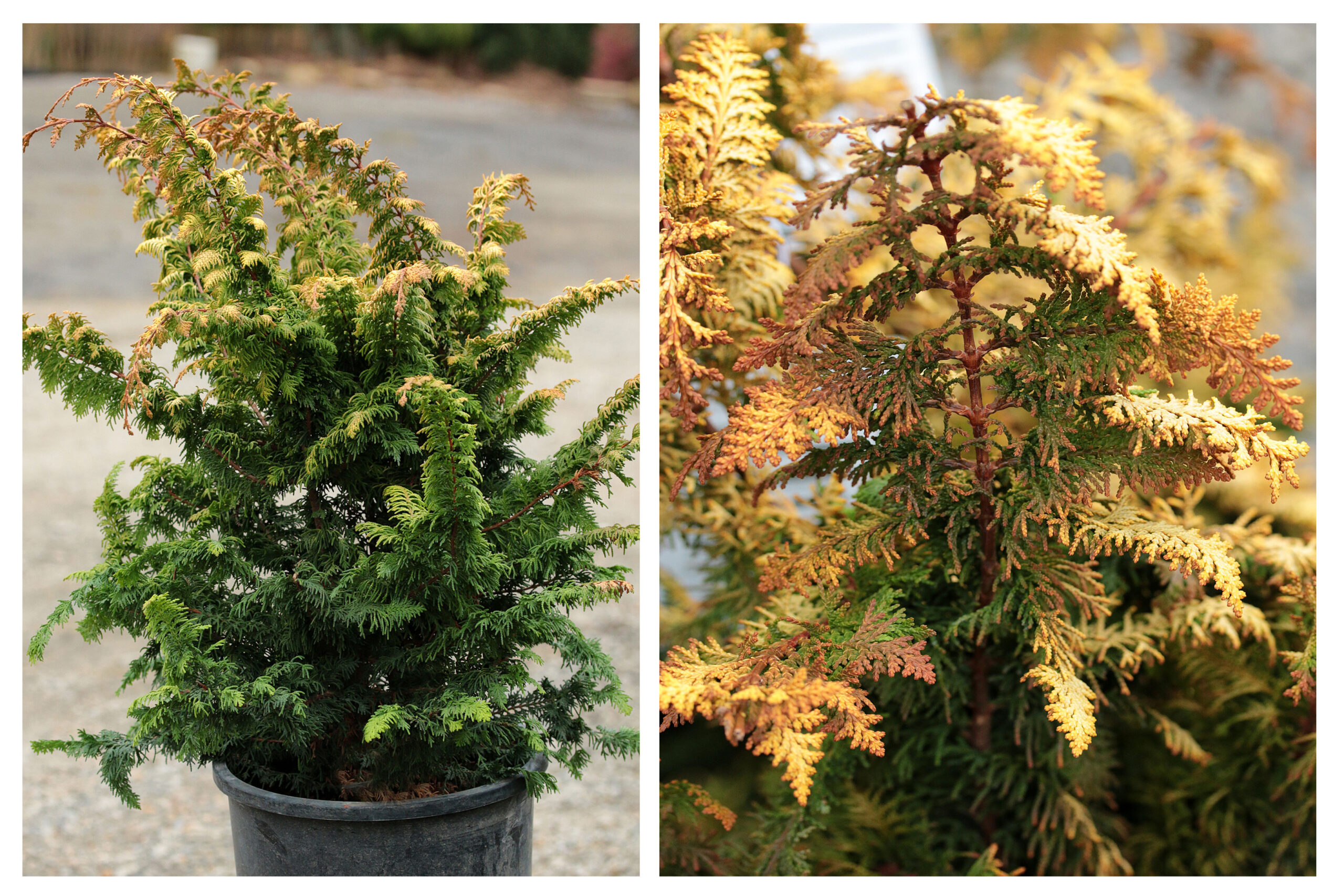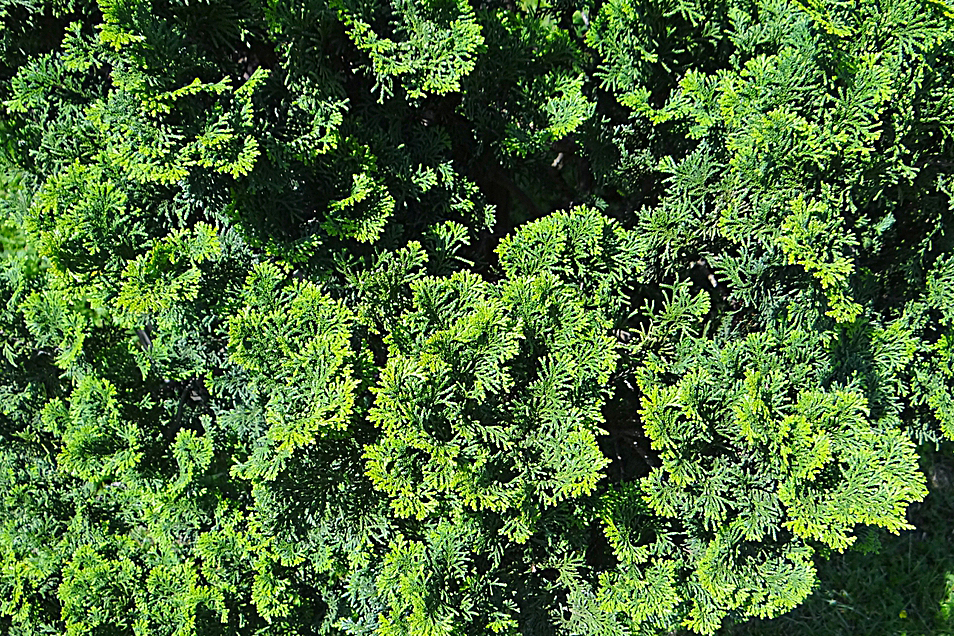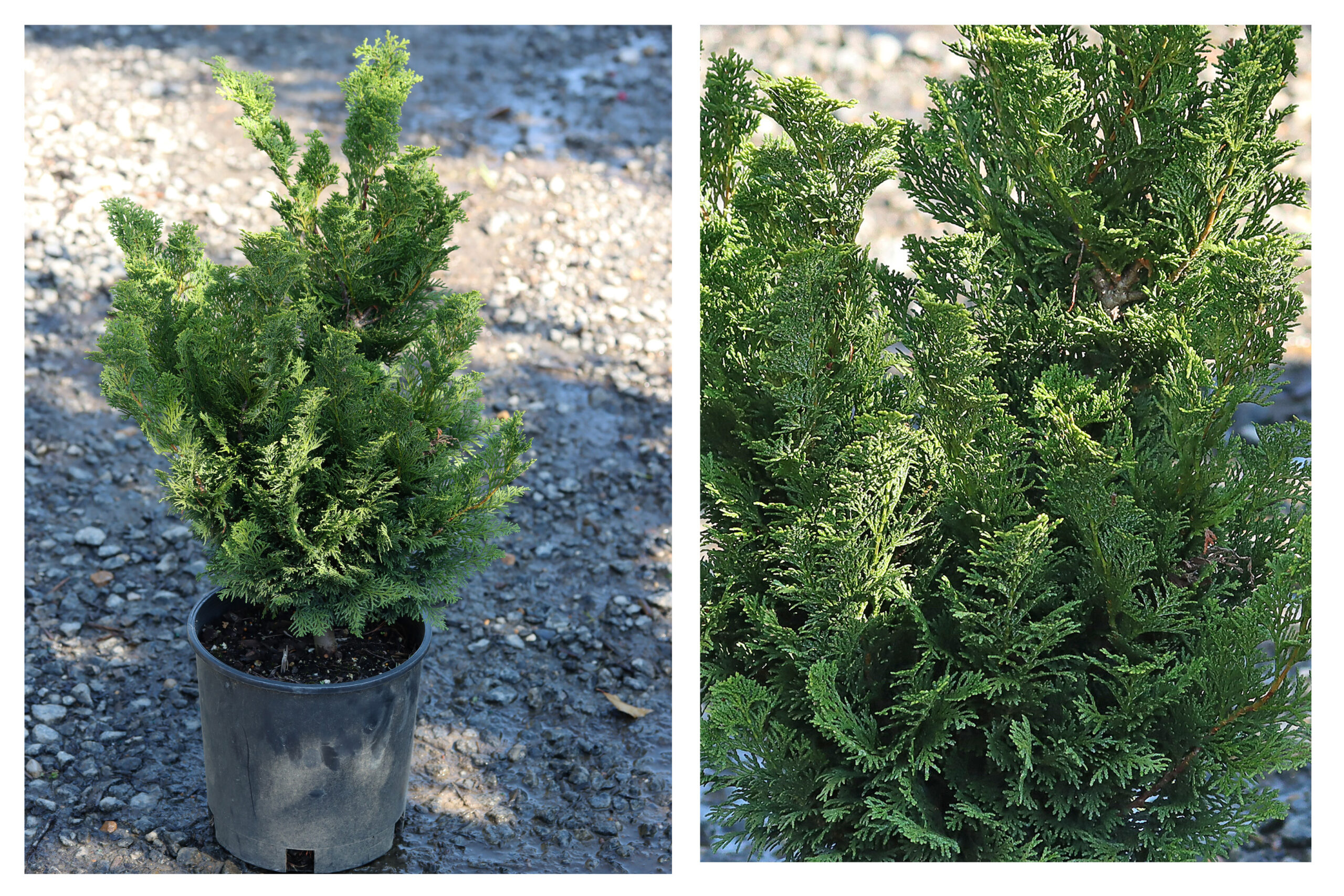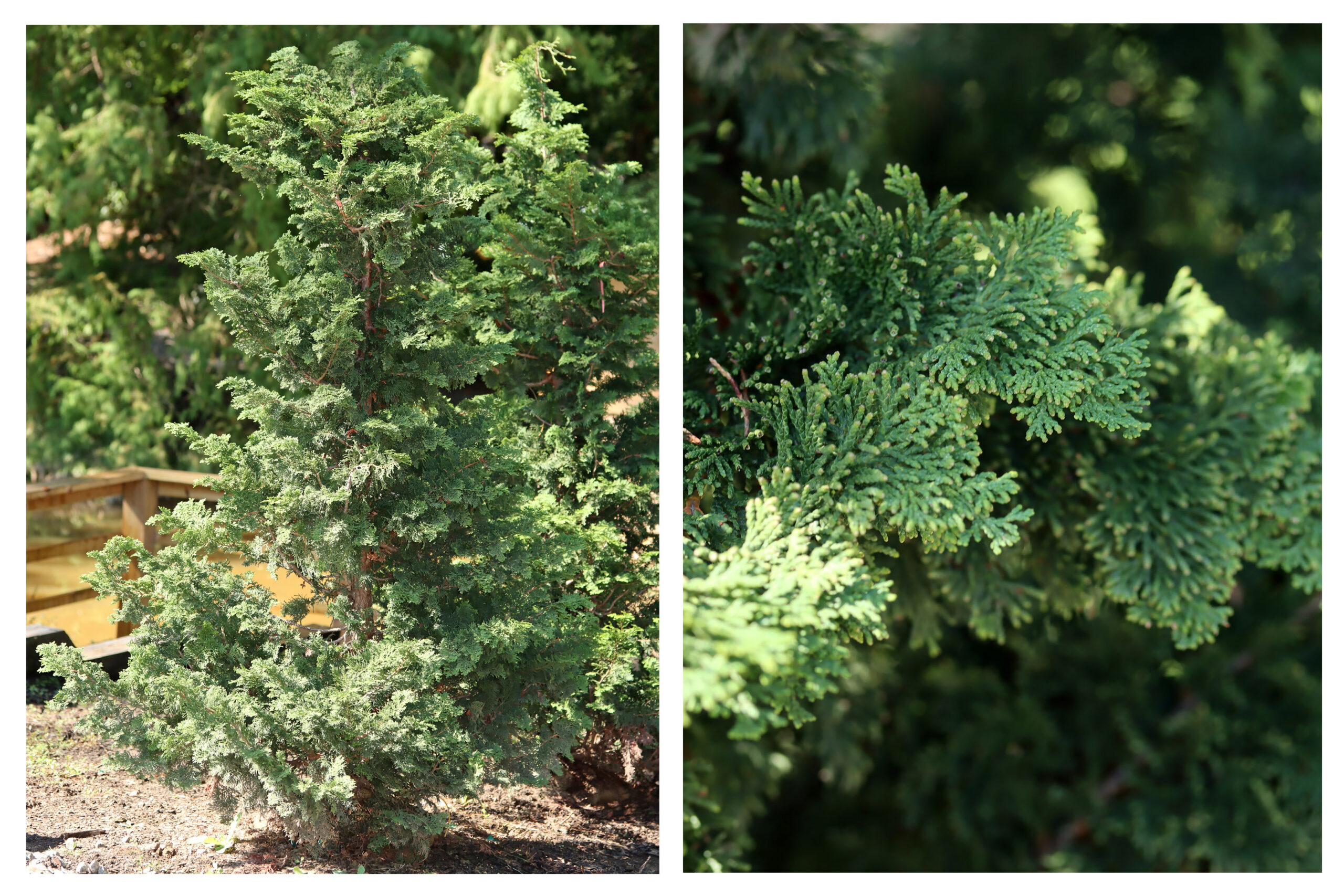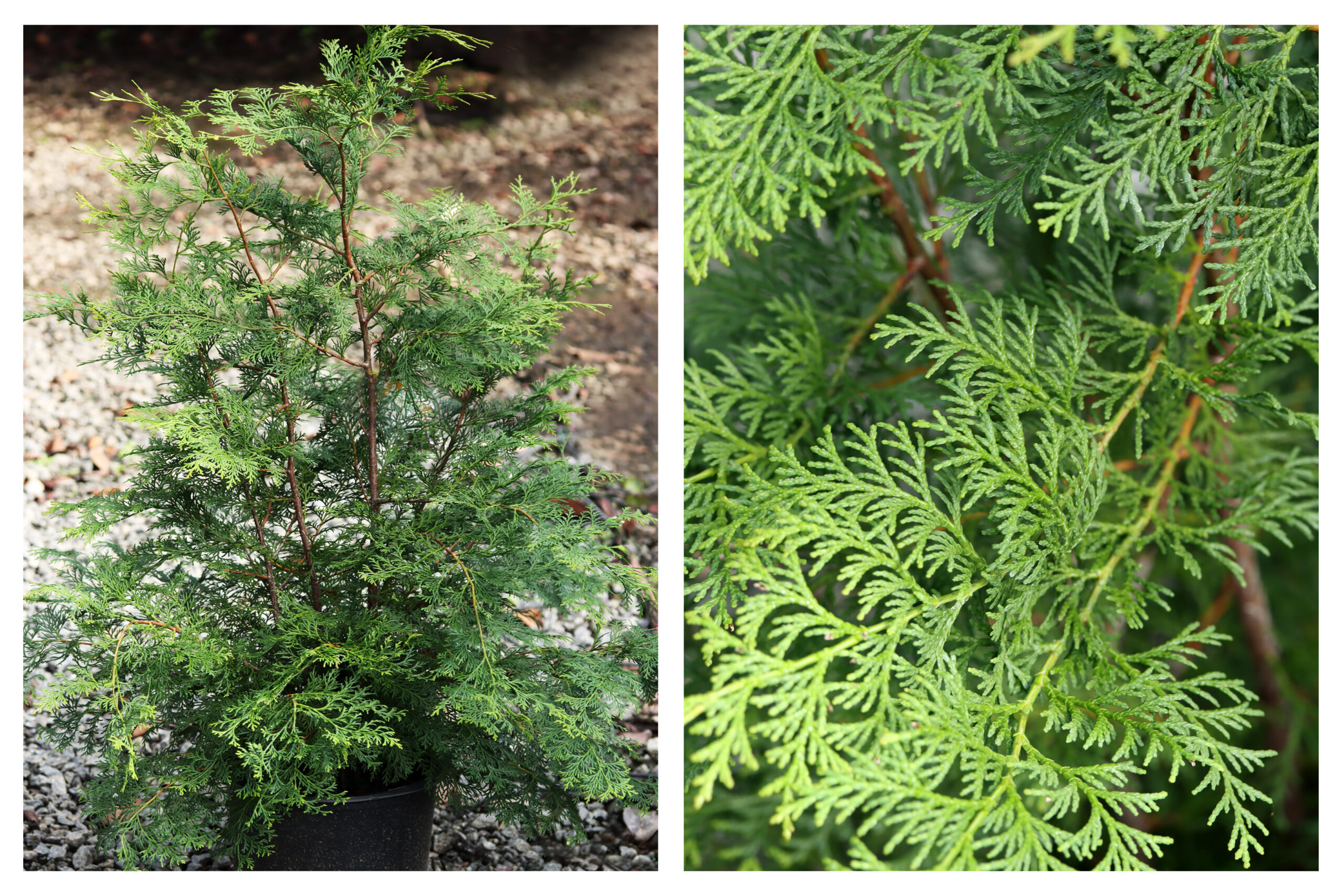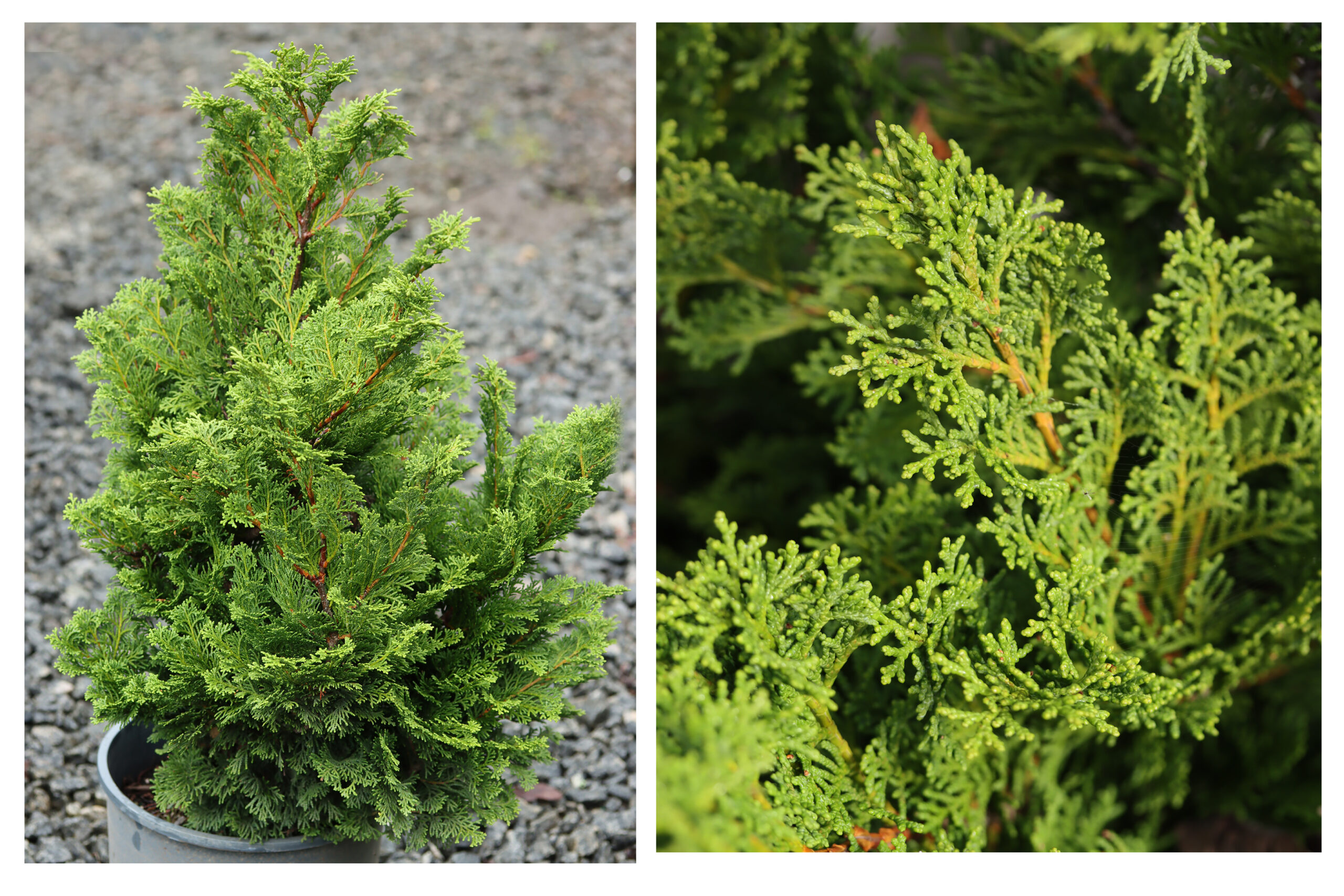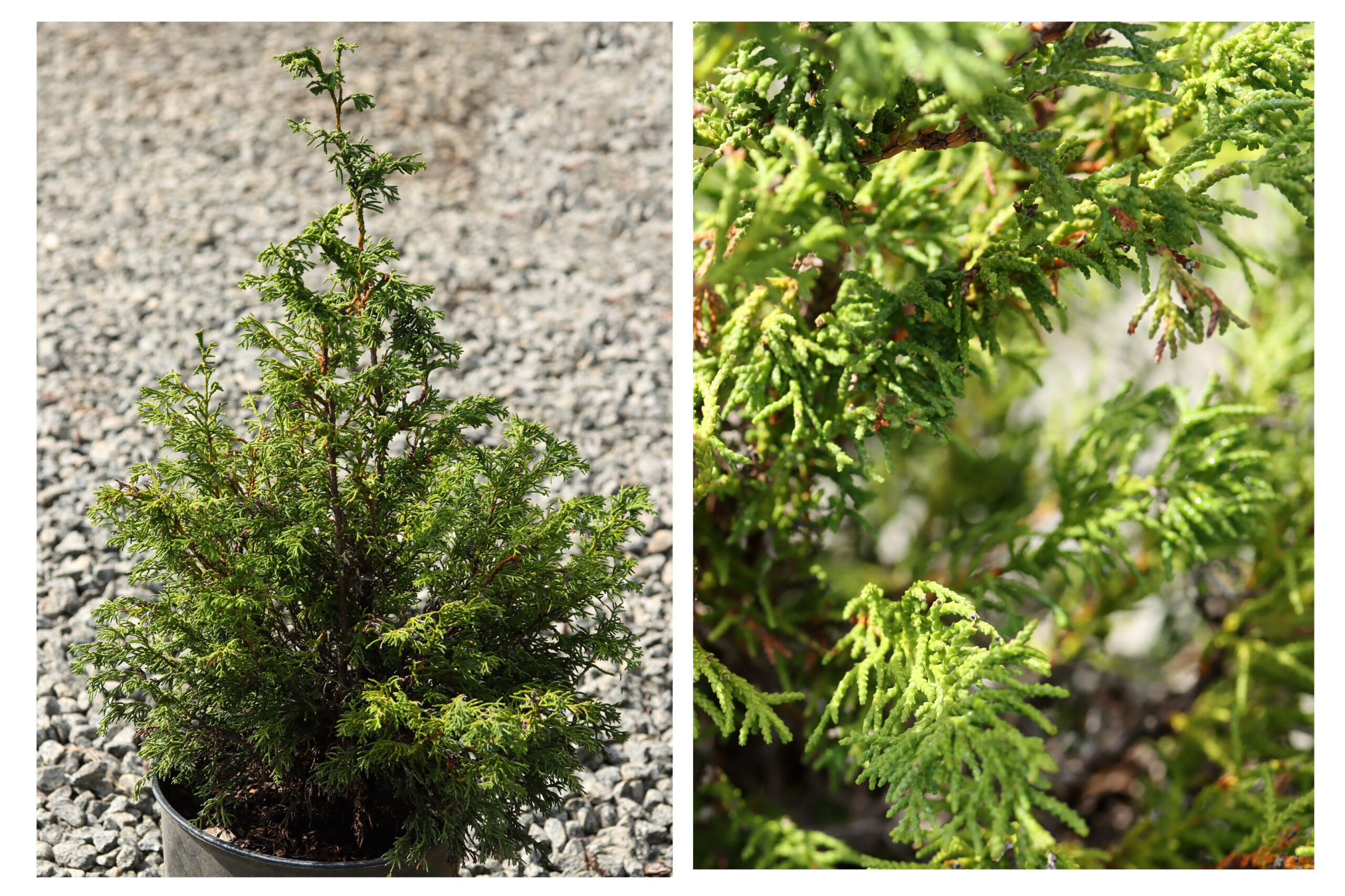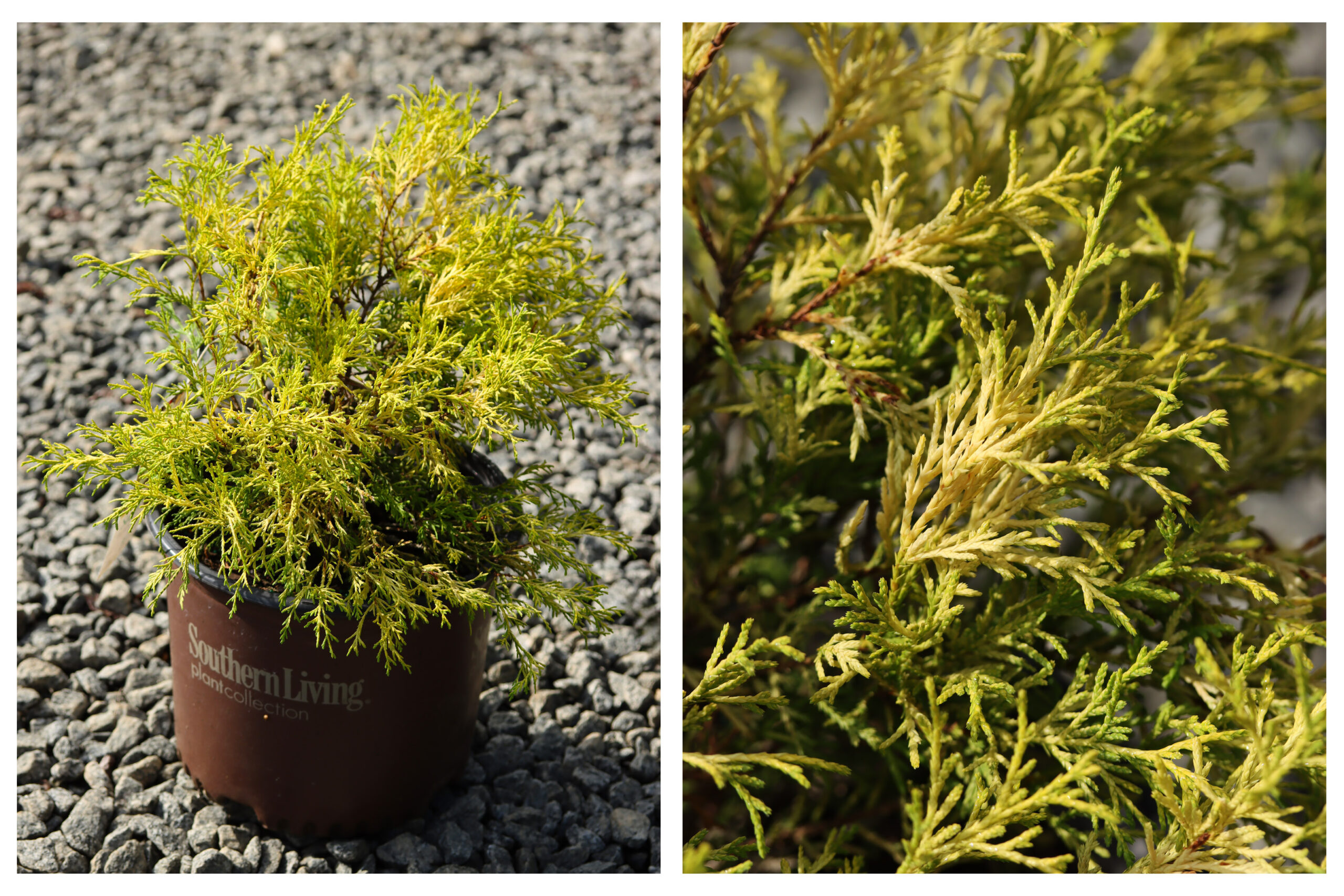All products are representative of what we typically hope to offer but do not indicate Inventory availability. Please contact us for availability on any specific product/s on (770) 926-8566, or through email at Info@TwinBranch.com or alternatively in person at the nursery
Conifers
Arborvitae (Thuja)
Annas Magic Ball®
A cute little mounded dwarf arborvitae native to North America with year-round bright yellow green foliage that needs no pruning. This evergreen shrub was developed in Canada, making it very winter tolerant and able to hold its color.
A wonderful choice for smaller yards and gardens and a great addition to perennial beds, rock gardens, troughs and containers, or any landscape project.
Requiring Part Sun to Sun conditions it grows to approximately 2 – 3 feet tall by 3-4 feet wide
Degroot's Spire
A dwarf cultivar of the evergreen American arborvitae or eastern arborvitae DeGroot’s scale-like rich green foliage becoming purple-tinged in winter and its sleek, compact, tailored, narrow pyramidal form, sets the tree apart from similar varieties.
As it only gets to between 3 -4 feet wide at the base and 15 – 20 feet tall at mature height this slow growing specimen is the perfect evergreen silhouette privacy tree for a tight vertical spot, as a specimen, accent, container, or patio planting, as a foundation planting or shrub border, for windbreaks, planting between buildings, driveway borders, and beyond. Pruning of its side shoots when the plant is young may be necessary to maintain its narrow habit.
DeGroot’s grows best in full sun to partial shade and loamy, moist, well-drained, acidic soils. Intolerant of dry conditions it should be planted in sheltered sites to prevent exposure to winter elements and wind damage.
Emerald Green
This classic beautifully shaped narrow, cylindrical shaped evergreen shrub is known for its gorgeous shimmering dense and lush Emerald green foliage. This makes it an excellent choice for accent planting, as a specimen or for hedges, and natural solid privacy screens.
Requiring Partial to Full Sun conditions the shrub is slow to moderate growing and reaches approximately 15 ft. tall to about 3 to 4 ft. wide.
Extremely hardy it does well in the heat and humidity of the south, will tolerate dry spells once it is established and, unlike other arborvitae’s, retains its vibrant color throughout Winter.
Simple to grow and wonderfully attractive all year long, you really can’t go wrong with this popular shrub that will add value and beauty to a range of landscapes.
Fire Chief TM – PP191009
A branch Sport of Thuga occidentalis ‘Rheingold’ Fire Chief’s very distinctive and striking color shifts set it apart among other compact evergreens. Intense fine textured gold foliage brightens the rounded, near perfect globe-shaped evergreen shrub in both winter and spring. Summertime brings gentle hues of orange to the growing tips of fine foliage, which then deepens to red -brown in autumn.
While suitable for Full sun to Part Shade conditions it appreciates light afternoon shade and does particularly well in a spot where it will not be buffeted by winds. Slow growing to approximately 2 to 4 feet tall and wide, the shrub is low maintenance, not fussy as to soil type, and will maintain its rounded globe shape without pruning.
A perfect option for massing in a landscape foundation, in a mixed bed, for borders, as a rock garden specimen or combined with other dwarf conifers.
Franky Boy
This Oriental Arborvitae Dwarf evergreen with an upright pyramidal form and slow growing, to about 4″ a year, makes a fantastic and unusual specimen or accent for the garden, containers and miniature and Asian gardens. Works fantastic as an unusual topiary.
Planted in full sun and growing to about 3-4′ tall and wide Franky Boy’s unique long filaments of thread-like lemon yellow golden foliage juts out from a lime green interior and turn a striking bronze-orange in the winter providing a great color contrast to other plants. The lovely foliage moves and sways in the breeze mimicking the effects of ornamental grasses without winter die-back.
The plant benefits from a light yearly shearing, cutting about 1/3 of the growth to encourage a formal, compact form and provide a proliferation of bright and colorful foliage.
Golden Globe
The distinct natural globe shape, short stature, tidy habit, and distinct evergreen golden yellow foliage color of the golden globe arborvitae make it a dream and wonderful landscape standout able to enhance any outdoor space.
Combined together, these characteristics make it a great option for lining a front path, creating consistency through borders or for use as a short hedge or screen.
Requiring Full Sun, to Partial Sun/Shade, with a slow to medium growth rate the tree reaches around to around 3-4 feet high and wide at maturity.
It’s tolerant of heat and drought once established.
Green Giant
Equally at home in Full sun or Light shade the Thuja Green Giant arborvitae is a large, tall, vigorous, fast-growing evergreen. Its natural pyramidal to conical form boasts dense, rich green foliage that darkens or bronzes slightly in the winter.
Growing rapidly up to 3′ per year and maturing at a height of approximately 50 feet and a width of 15 feet this is an exceptional landscape tree that has become one of the mainstays in our Southern Landscape enduring through the seasons. Excellent for use as a screen, hedge, or single specimen it is also resistant to wind once established and can withstand heavy ice or snow, making it a good choice for a natural windbreak.
When young it does not tolerate prolonged periods of drought so adequate watering is paramount to its overall happiness.
Jantar
A pyramidal and upright selection of arborvitae with bright, invigorating golden-green foliage that will add a dramatic contrast to your landscape all year round.
In comparison to other yellow selections of arborvitae, the tree features many more lateral branches which result in a much denser look.
“Jantar” translates into “amber” in the polish language and is an accurate description of the plant’s winter color. As cold weather approaches, the color change begins resulting in a transformation that is quite captivating.
Slow-growing – after 10 years in the landscape, one can expect a mature specimen to stand about 6 feet tall and 18 inches wide, suggesting an annual growth rate of slightly less than 1 foot a year in most locations.
This emerald arborvitae requires full sun (at least 6 hours) and is great for specimen or accent planting, hedges, privacy screens, and shelter-belts. It also makes a good and useful foundation plant.
Linesville (Mr. Bowling Ball)
A dwarf rounded gem with a perfect, dense, globose and compact habit that combines elegance with resilience and adding a touch of sophistication, beauty, and a lush green backdrop to the landscape.
Its evergreen foliage differs from usual Thuja varieties with its lacy soft fine pastel blue-green coloring and feathery appearance. This variety maintains its vibrant color throughout the year resisting winter discoloration and retaining its shape without pruning or shearing.
Thriving in full to partial sunlight, and slowly growing to a mature size of 4 feet by 4 feet, it is perfectly adaptable to various garden settings it works well in group plantings, as a standalone feature, part of a curated garden design or as a handsome border along sidewalks, paths, and walkways.

Rheingold
Wonderful in both form and color ‘Rheingold’ arborvitae, a cultivar of the American arborvitae, is a woody evergreen shrub in the cypress family (Cupressaceae).
As a young shrub it is more of a dense compact globe shape and displays golden-yellow juvenile top foliage in spring and summer changing to a dark strong coppery color in Winter providing lovely seasonal interest. As it matures it takes on more of an upright conical form and develops more scale-like foliage.
It grows well in full sun or partial shade reaching a mature size of around 4 feet tall by 4 feet wide in 10 years. Full shade should be avoided as this will dramatically thin out the foliage.
This shrub may be used as a foundation plant, in borders, or in mass plantings.
Sugar and Spice TM
Sugar and Spice is a slender, upright, and conical Arborvitae that is a smaller form of western red-cedar, and is ideal as a graceful accent plant, or for narrow hedges, smaller garden spaces and containers.
Growing well in both sun and partial shade Sugar & Spice Thuja produces extremely attractive bright light creamy- green, feathery foliage that provides a unique fern-like texture in the landscape and holds its color well throughout the winter. Growing to only 3 feet wide and 10 to 12 feet tall, Sugar & Spice won’t require pruning to keep its narrow conical shape.
Thriving in almost any soil, except for very dry ones and very wet ones Sugar and Spice is a very hardy evergreen that won’t disappoint!
Unlike most other arborvitae, deer fortunately usually leave them alone and they exhibit no significant pests or diseases.
Tater Tot ® Thuja occidentalis
Naturally growing in an appealing evergreen globe shape and so extremely cute and versatile, native Tater Tot arborvitae is the perfect dwarf plant accessory for your landscape. Its neat, rounded shape is ideal for sprucing up any space in your yard and it’s extremely easy to grow and care for.
Perfect in hedges, borders, containers, & small spaces it grows to 2′ tall x 2′ wide at maturity and requires sun to part sun conditions.
Deer resistant.
Whipcord Western Red Cedar
A dense, multi-stemmed evergreen shrub with finely textured, green foliage and gracefully arching branches. Foliage turns bronze in winter. Excellent for use as a specimen plant or in group plantings for added appeal in the landscape.
Slow-growing, drooping dwarf mop form that features whipcord-like glossy green foliage. The foliage usually acquires bronze tones in winter. Novel specimen in a casual garden and great for Foundations and rock gardens. Requiring full sun, it grows to a height of approximately 5 feet and width of 4 feet
Cedrus Atlantica
Glauca (Blue Atlas Cedar)
Native to the Atlas Mountains in northern Africa this is a lovely and unique evergreen tree and a delight to have in your landscape for year-round interest. Reaching 30 – 50ft high by 20-30ft wide it has distinct ascending horizonal branches with a cluster needle formation that makes for a great focal point. Over time it forms a large pyramidal shape. It’s foliage is a striking Sky blue to blue gray.
A showpiece for the home it adds character to the landscape and looks wonderful in a mixed bed or in front of your home. It is also ideal for a rock, cottage, Asian-inspired, or Zen garden.
It does well in warmer weather and can do acidic or alkaline soil, but it needs to be well drained.
This tree is hardy and fairly easy to grow. It is pest and disease resistant and drought and pollution tolerant. It can go into transplant stress where the needles brown and drop but will re-flush nicely.
Glauca Fastigiate (Columnar Blue Atlas Cedar)
Narrow, upright form of cedar with fabulous, stiff and vibrant grey-blue colored needles. A single vertical trunk with lovely ascending branches contributes to the striking and majestic character and shape of this tree.
Fastigiata’ will grow as tall as the species, but its slender footprint requires far less space making it a useful option in design where space is at a minimum. Typically reaching 25 feet tall and approximately 10 feet wide in the average landscape the tree requires little to no maintenance and is not beset with pest and disease issues. In addition, it’s exceptionally drought, heat, and humidity tolerant.
A long-lived and easy-to-grow columnar makes for a most striking vertical accent tree or specimen in sunny gardens and landscape borders or to line a drive or other avenue. It can also be planted in groupings and makes for a great privacy hedge or living fence.
Glauca Pendula (Weeping Blue Atlas Cedar).
Growing 12-14ft high by 14-16ft wide Glauca Pendula is a columnar, weeping form featuring pendulous branches, with no well-defined central leader, and clad with beautiful powdery steel bluish-green needles in clusters and upright, barrel-shaped cones. The tree makes a sculptural and dramatic statement in the landscape. Its height and form can be controlled and determined by training its central leader. With proper support, the central leader will grow in a narrow upward direction. Without support, this same leader will tend to cascade downwards in a variety of directions.
This specimen requires ample room to grow allowing the branches to spread and cascade freely. With adequate room, no pruning is required. Plant height and width will depend on how the plant is staked and trained in its youth; staking is necessary to keep the plant from being prostrate (creeping along the ground).
Requiring full sun (6 or more hours of direct sunlight a day) it prefers growing in soil conditions that are deep, acidic, and containing loam. It can however tolerate and be grown in other clay or sandy soil environments, with pH that is neutral or alkaline and is resistant to drought, heat ,and humidity.
Glauca Pendula Serpentine (Blue Atlas Cedar Serpentine).
If you’re looking for a charismatic and dramatic tree that’s simply brimming with personality and interest the Serpentine may just be it.
This evergreen conifer that measures in at around 10 feet tall, 15-20 feet wide, depending upon training, displays sprawling, drooping twisted foliage filled with powdery icy-blue needles and makes for a wonderful specimen for the home landscape. Adding contrast, color, year-round appeal, and unique beauty it is sure to catch the eye of every passerby.
The Blue Atlas Cedar ‘Serpentine’ thrives in full sun and well-draining soil and is known for its drought tolerance once established.
Naturally slow-growing the serpentine’s adaptability to various garden styles and its enduring, sculptural quality contribute to its popularity as an exceptional and attention-grabbing tree cedar. It’s a perfect focal tree in Asian, cottage, Zen, modern, rock gardens or in a mixed bed surrounded by just about anything!
Cedrus Deodara
Bills Blue
Bill’s Blue Deodar Cedar is a broad tree pyramidal in habit with attractive and elegant grey-green foliage and graceful slightly arching branches. Prefers full sun and rich, moist acidic well-drained soils of average fertility.
Growing to approximately 30 to 40 feet high by 15 to 20 feet wide at maturity they are useful in the landscape as a Specimen or in mass plantings, borders, naturalized areas, as screens, in Woodland Gardens, or to provides shade.
Heat and drought tolerant once established they require little to no maintenance.
Divinely Blue
Named after Bill Devine, a retired propagator from Maryland, Devinely Blue is a dense semi-dwarf evergreen that is wider than it is tall. As a young plant it’s fairly similar to ‘Feeling Blue’ but as it matures it assumes a mounding habit with a flat top. As it ages further it develops a more conical shape.
This lovely tree produces long and attractive needles in a stunning and unique light blue-green color that surrounds the branches with drooping tips. A slow to medium grower, adding around 3-6 inches a year it is a well-behaved tree reaching up to around 5 feet in height and 6 feet in width after about 10 years.
Best planted in full sun to light shade in a somewhat sheltered location if possible where the soil is acidic and well-drained. Heat, humidity and drought tolerant after being established are also resistant to the browsing of deer.
It can be pruned to shape but will look its best when left in nature’s hands.
Feelin Blue
The lowest of the dwarf cedars, with a prostrate spreading form that rarely develops a leader this delightful evergreen extends to 4 to 5 ft. tall, spreading 6 to 10 ft. wide in 10 years.
It’s unique form with its striking blue-green foliage makes it a wonderful specimen for smaller spaces, rock gardens and containers – it also makes for an excellent topiary that may be trained into upright or patio tree forms.
It is intolerant of poorly drained wet soils performing best if grown in deep, moist but well-drained, acidic loams in full sun. Drought tolerant once established it displays the best tolerance of the true cedars for hot and humid summers.
Patti Faye
A classic medium growing conifer, Patti Faye with its exceptional blue foliage (the bluest of any deodar) loves the sun and is low maintenance and deer and drought tolerant.
This specimen has unique horizonal branches and requires space to grow and as they reach 45 to 50 feet or more in height and 20 to 30 feet wide. Ideal for use as a specimen focal point in your landscape or in privacy screen plantings. Avoid planting the tree in areas that are subjected to a lot of wind.
Planting in the fall once the plant has gone dormant in preparation for winter is an ideal time as it will not require as much sun or water as it would in the spring.

Spp. Species
60ft high by 30ft wide. Has pendulous branching with a weeping appearance. Can have blue grey to green foliage. Trunks can crack in extreme cold. Heat tolerant. Can be used in groupings or as a specimen.
Cephalotaxus Harringtonii (Plum Yew, False Taxus)
Dukes Garden
Discovered at Duke Gardens in Durham, North Carolina and is noted for its compactness and vase shape. Great shade foundation tolerates both the summer heat and humidity. The foliage is deep green with light green new growth. Needles are whorled around branches.
It can be kept in hedge form or left to natural and works well in small spaces, a woodland or shade garden as an accent or planted in mass along a border. A male cultivar it will not produce fruits. Grows best in well drained loamy soil but tolerates dry, sandy, or clay soil. Grows 4-5ft high by 4-5ft wide.
Once established this plant is drought-tolerant and deer resistant.
Fastigiata
Carefree Columnar shape. Exceptional, dense, finely textured, shiny, dark deep green evergreen foliage with light green new growth is deer resistant. Accent or anchor. Great as a focal point in a shade container garden it makes fabulous foundation plant or landscape specimen that is both heat and shade tolerant.
Grows best in well drained loamy soil that stays moist, with morning sun and afternoon shade. Once established, prefers regular moisture but tolerates brief drought. Grows 8-10ft high by 4-5ft wide.
For a tidy appearance, prune annually to shape.
Gold Dragon
Certain to brighten up your garden this fabulous Golden Dragon Plum Conifer is an elegant evergreen plant that has all of the great features of other Plum Yews – they’re tough, they’re deer resistant and they take sun or shade.
With their low and spreading vase-like habit (Height 2 to 3 Feet and Spread 4 to 5) and attractive arching branches covered with glossy, flattened, bright golden yellow needles these shrubs provide an incredibly unique and outstanding texture and color in the landscape.
Golden Dragon will grow in shade or full sun in Zone 7 but likes a break from direct afternoon sun in in zones 8 and 9. For the best golden foliage color at least 4 hours or more of direct sunlight is recommended.
Korean Gold
Introducing an upright, vase-shaped conifer with exceptionally long needle-like deep yellow-green foliage arranged radially around ascending branches. This is a unique and beautiful shrub that has a subtropical appearance and will certainly make a statement piece in the landscape. It requires a couple of hours to get the yellow color.
Similar in growth habit to Dukes Garden. Grows best in well drained loamy soil. With an annual growth rate of 3-5″ it will reach a height and width of 6-10 ft high by 3-6ft wide.
Exposure is sun to part shade – color holds up well through the summer months and changes to a rich lovely green in the winter.
Prostrata
‘Prostrata’ has a low growing spreading mounding habit. Deep green with light new green growth. 1-2in long needles lay flat giving it a weeping appearance. Grows best in well drained loamy soil that’s stays moist but tolerates dry, sandy, or clay soil. Requires partial shade and tolerates shade better than most other needled evergreens. Also tolerates well both the summer heat and humidity unlike other yews.
Once established this attractive and versatile plant is drought-tolerant and deer resistant. ‘Prostrata’ grows very slowly to 2 to 6 feet tall and wide.
‘Prostrata’ works well as a specimen plant, used along a foundation, as a low hedge, planted under the canopy of trees, or mass planted along a border. Also, a useful option planted in a woodland setting or in a shade or winter garden.
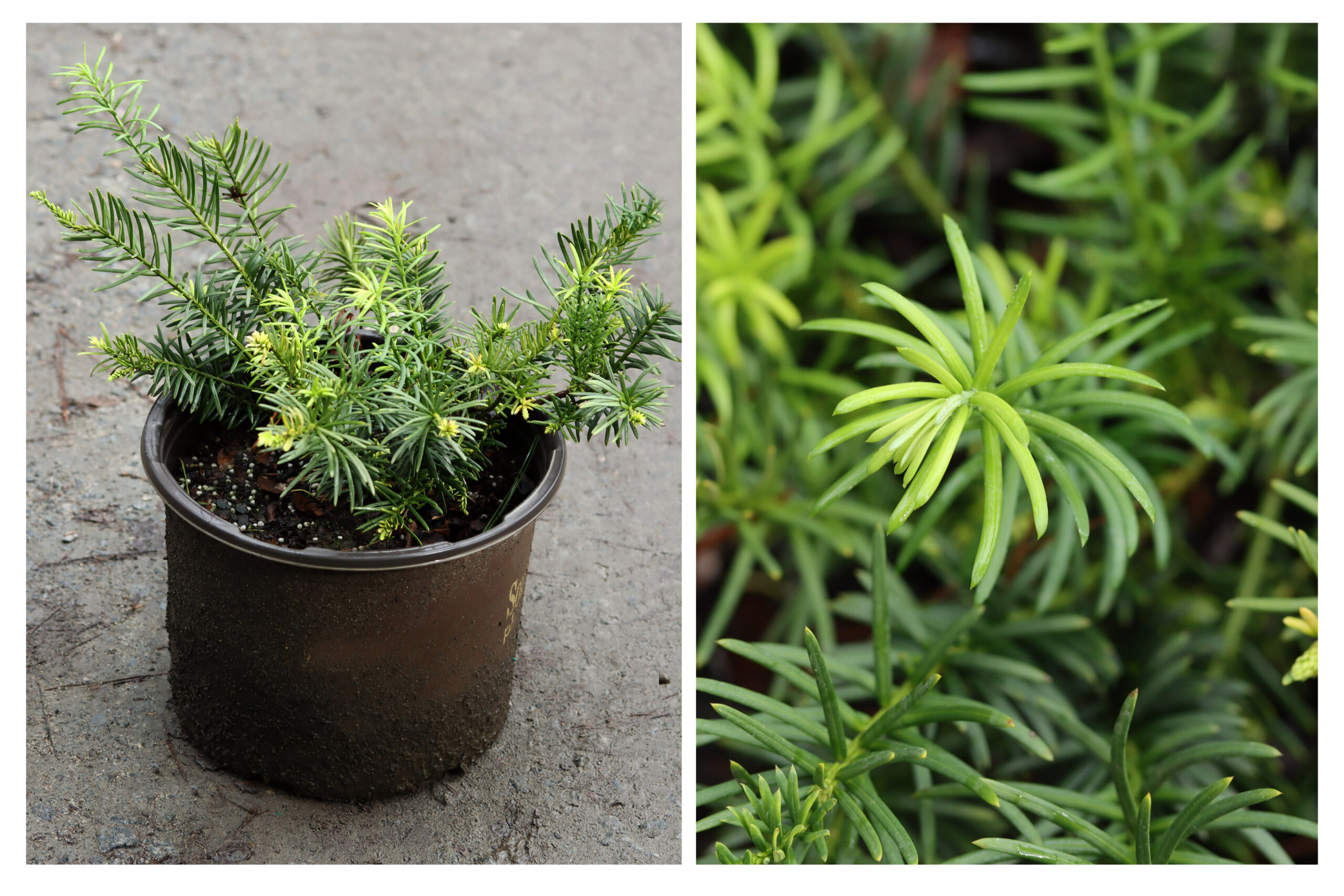
Yewtopia
Charming and hard-working, small, tidy evergreen shrub providing year-round color and definition. The erect branches grow up and out into a vase-shape, giving these petite evergreens a somewhat energetic look.
Adding a subtle, elegant evergreen display to your garden they hold their dark green color in sun, shade, winter, spring, summer, and fall. New growth adds a lighter shade for dimensional interest.
Can take some direct sun just not hot afternoon. Similar to Dukes Garden but has a looser appearance. Can be kept in a sophisticated hedge form or left to be natural. Grows best in well drained loamy soil. Very low maintenance and tolerant of heat, pests, deer, humidity, and even periodic drought. Grows to approximately 3-4 feet tall and wide.
Although the spring blooms are insignificant, you may see tiny, plum-shaped fruit in fall on female plants. Pruning is not required.
Chamaecyparis (False Cypress, Japanese Cypress) – OBTUSA
Obtusa Aurea
Growing to approximately 15-20’ high x 12-15’ wide ‘Aurea’ is a full size, broad, upright golden version of the species with pyramidal form and spreading, graceful branches.
The well-cupped outer sprays and new foliage of this naturally irregular conifer are warm, rich golden yellow, while the interior and older foliage provides contrast with rich medium green.
Though the foliage is dense attractive, reddish-brown bark that develops a striking texture with age peaks through. Does best in Sun to Partial Shade with moist, well-drained soil and afternoon shade in the summer.
A lovely long-lived specimen it is perfect for use as a focal point specimen in landscape borders, to frame corners of homes or other buildings, for use in privacy screen plantings and in containers. In addition, makes for a useful topiary forms.
Obtusa Blue Feathers
Also known as Ivans Column Hinoki False Cypress this is a compact dense cultivar with a flattened globe shape. Its abundance of juvenile foliage into maturity gives it a frilly, feathery, fine-textured, and airy appearance which is further enhanced by the outstanding hues of its blue foliage – especially in the sun.
Slow growing it may eventually attain a height of 12′ and a spread of 6’and is the perfect choice for gardens where space is limited. It’s preference is for moist, well-drained soil in full sun or very light shade. It will do its best on acidic sites.
Whether planted as a focal point or accent, grouped together, or used to create visual interest in borders or containers, ‘Blue Feathers’ is sure to captivate with its unique beauty and striking color adding a touch of elegance to any landscape.
Obtusa 'Crippsii'
One of if not the best of the yellow conifers. Displaying spectacular golden foliage, it grows rapidly into a small tree – its dense, pyramidal form reaching about 12 to 15 feet in height with a 6 to 8 feet spread.
Bright graceful gold fern-like foliage emerges in spring and dark green fragrant foliage with golden tips are on display all year round. While it is easily grown in ordinary garden conditions it grows best in moist, rich soil that is well-drained in a location that provides full sun for the strongest foliage cover. It will however tolerate some shade or filtered sunlight. Once established it is moderately drought-tolerant but prefers a steady supply of water to perform at peak.
It is an excellent choice as a focal accent specimen, in hedges and privacy screens, in landscape foundation plantings, or for softening the corner of homes or other buildings.
Resistant to deer and with no significant pests or diseases this classic specimen certainly attracts visual attention and admiration whenever seen.
Obtusa 'Conschlecht' PP24666 Night Light™
A striking evergreen shrub with a dense, rounded habit that seems to tolerate full sun with no noticeable leaf burn during the summer months or cold burn during winter months. It’s colorful golden yellow foliage becomes bronze in the winter with green on the interior.
Grows easily in average, medium moisture, well-drained soils in full sun to part shade. Best in full sun sheltered from the wind. Prefers moist, fertile soils, well-draining soil – avoid wet feet.
Growing to a height and width of 4 to 5 feet it is a lovely and useful option as an accent plant, in mixed or shrub border gardens, as a container plant, to create a low hedge or in mass plantings.
Obtusa Fernspray Gold
Displays classy, arching sprays of golden, fern-like foliage. Each unique, flattened branch tapers to a point, just as a fern frond does rich gold at the ends, and more chartreuse green deeper inside.
It requires full sun and ample moisture to achieve the brightest color, but benefits from some afternoon shade in hot summer climates. Fernspray Gold grows at a moderate rate to reach about 6 feet tall and 3 feet wide in 10 years or so, and it continues to grow slowly, eventually passing 10 feet or more in height.
This is a lovely sized conifer to brighten the garden throughout the year and especially during the bleak days of winter.
Obtusa Nana Compacta
A multi-stemmed dwarf evergreen shrub with a distinctive and refined pyramidal form. It has dark green evergreen foliage which emerges light green in spring. The scale-like sprays of foliage remain dark green throughout the winter.
A relatively low maintenance shrub it is highly tolerant of urban pollution. It does best in full sun to partial shade and will grow to be about 5-6 feet tall and wide at maturity. With a preference for average to moist soil conditions, it shouldn’t be allowed to dry out.
The shrub lends an extremely fine and delicate texture to the landscape composition which can make it a great accent feature on this basis alone. Wonderful option as an accent, in mass planting, for hedges/screening and for general garden use.
Obtusa Nana Gracillus
A popular and well-known compact, dense, dwarf evergreen shrub with rich green cups of foliage in the Cupressaceae (cypress) family. It has an irregularly globose form that develops an upright habit with age.
Best grown in average, moist, well-drained soils and protected from harsh winds. Slow growing, with reliable structure, it does best in full sun but will tolerate partial shade. In 10 years, it will only reach 3 to 4 feet tall but will eventually mature to 6 feet or more with a 2-to-4-foot spread.
Providing winter interest with its graceful, dark-green needles it is a great option in small spaces, Asian or rock gardens, containers, or as a specimen.
It can also be used in bonsai.
Obtusa Slender Gracillus
Slender Gracillus/Slender Hinoki false cypress is a needled deep green colored evergreen growing more compact and fuller than the genus in a pyramidal to a conical shape with short spreading and irregularly arranged branches. It grows slowly and will reach 8– 12 feet high with a 4–5-foot spread. Latin for gracilis translates to “graceful.”
Grows best in full sun but can take some morning shade or light to dappled shade. Shelter from drying winds. It will adapt to most soil types as long as they are moist and well-drained. Once established the tree is fairly drought tolerant. It needs little to no pruning except to remove damaged branches. This tree prefers some protection from the wind.
This graceful tree makes a nice accent or specimen tree, a corner of the house plant, planted in small groups or as a hedge and privacy screen. It also does well in containers.
Obtusa Southern Lace
A fast-growing, low maintenance non-flowering evergreen conifer with an open-branched pyramidal habit and arching branchlets adding a touch of elegance to any landscape. The beautiful soft, delicate flat scale-like leaves stay a medium green and have a light scent.
Its small cones are green-brown (female) or orange-brown (male) depending on gender. Prefers full sun and moist well-drained soil. Southern Lace is drought and disease resistant.
Growing to around 15-25ft high by 8-12ft wide this gorgeous conical upright tree is the perfect option for those seeking both beauty and versatility in their gardens.
Obtusa Tempelhof
A vigorous loose growing habit in a pyramidal form producing coarse, lush evergreen foliage in broad overlapping whorls. The golden-yellow outer foliage contrasts with the darker green inner foliage, giving it a two-tone effect in the landscape. The scale-like leaves take on bronze and copper shades in the winter.
With a preference for moist well drained soil the shrub endures light shade well, but its foliage will be fuller in full sun. Slowly reaching 8 ft. tall, 4 ft. wide this beautiful, carefree dwarf specimen is wonderful for foundation planting or placed in front of crawl spaces or utility boxes. It will also provide an excellent background for perennials and be used as a border or low informal hedge, lending its ornamental nature everywhere it goes.
Low maintenance it requires very little pruning. Remove any dieback and only the new growth of the current season for best results.
Resistant to deer and rabbits.
Obtusa Torulosa Nana – Dwarf Twisted Hinoki
A lovely but extremely rare variety that was selected from a witches broom on a Twisted Hinoki Cypress at Cham. o. ‘Torulosa’ at Klyn Nurseries. ‘Torulosa Nana’ is a dwarf variety that looks much like its parent but with everything 1/3 of the size. It’s a very slow grower, the contorted, twisted, and irregular evergreen foliage forms on a more compact plant developing into a compact mound that might reach 3 feet tall by 3 feet wide in 10 years.
Twisted scale-like leaves are dark green and highly ornamental, and the shrub features reddish bark evergreen. Growing best in full sun in average, moist, well-drained soils Dwarf Twisted Hinoki Cypress is low maintenance and an excellent option as a specimen in small rock, conifer, or Asian gardens.
It’s also perfect in containers and an excellent candidate for bonsai.
PISIFERA
Paul’s Gold®
A heat tolerant conifer with very attractive cascading golden evergreen foliage is a spectacular choice for year-round interest and appeal. Best planted in full sun but can take light shade. Requires moist well drained soil.
The shrub usually matures at 5-6′ tall with a 6′ spread but can grow a lot bigger. It does very well in extreme conditions and its disease resistant foliage means low maintenance for a stress-free garden. Its smaller size can be maintained by cutting vertical leaders inside of canopy.
Perfect choice for borders, Accent, Container, Foundation Planting, Hedge, or as a Specimen.
